
WOMEN BUILD
Ashley Switzer with Show-Me Central Habitat for Humanity –Impact COMO winner for Most Impactful Event/Fundraiser






WOMEN BUILD
Ashley Switzer with Show-Me Central Habitat for Humanity –Impact COMO winner for Most Impactful Event/Fundraiser






Greg Jones, J.D., Senior Vice President, Private Client Advisor,

Understanding the basics of your taxable estate is critical to allocating wealth in a way that aligns with your goals. What assets are included in your gross estate, which deductions can be applied, and how taxable gifts impact how much estate and gift tax is owed are important considerations for preserving wealth and minimizing tax liabilities for your beneficiaries.
What assets are included in my taxable estate?
The IRS considers everything you own to be your “gross estate” and will calculate your estate tax liability based on the value of your gross estate, including, depending on the type of asset, part or all of jointly owned assets, as of the date of death. Assets like real estate, investments, cash, life insurance proceeds, trusts, annuities, valuable personal property, and business interests are included and assessed at fair market value.
Which federal estate tax deductions can be applied?
Federal estate tax deductions can lower the value of your gross estate, which may lower how much estate tax is due. Common deductions include funeral expenses paid by the estate, estate
administration expenses, certain outstanding debts, charitable bequests, and the value of property that passes to a surviving spouse. For residents of states that levy estate taxes at the state level, state estate taxes paid or anticipated to be paid are also deductible.
How do taxable gifts impact my estate taxes?
Taxable gifts made over your lifetime can potentially increase your estate tax liability. Taxable gifts are recognized when cash or an asset that is greater in value than the annual gift tax exclusion amount ($18,000 per individual in 2024) is transferred to someone other than your spouse.
Any gift over the annual gift tax exclusion amount requires submitting Form 709, a gift tax return, to the IRS. If you still have estate and gift tax exemption remaining, there will be no tax paid but Form 709 will capture the use of that exemption.
What federal tax exemptions can I use to lower my estate taxes?
The federal estate and gift tax exemption combines the cumulative taxable gifts made over your lifetime and the value of your taxable estate to determine how
much of the exemption amount is used to transfer assets tax-free. Any sum over the exemption amount is subject to a progressive tax that can quickly rise to a 40% maximum estate tax rate.
The federal “generation-skipping transfer” (GST) tax exemption allows gifts given to a “skip person,” someone two or more generations after the donor’s generation, to transfer tax-free up to a certain amount. This exemption is separate from the federal estate and gift tax exemption, but both exemptions are based on cumulative wealth transfers over your entire life such as taxable gifts given during your life and the transfer of your estate at death.
Navigate estate tax complexity with Commerce Trust
Commerce Trust uses a holistic and personalized approach to estate planning, partnering with your estate planning attorney or tax advisor when needed to ensure your estate plan is tailored to your goals. Contact Commerce Trust today to initiate estate planning discussions and learn how our financial planning, investment portfolio management, trust administration, and tax management* professionals work together to develop a comprehensive estate plan under one roof.
*Commerce Trust does not provide tax advice to customers unless engaged to do so.
The opinions and other information in the commentary are provided as of September 26, 2024. This summary is intended to provide
the reader and audience.
This
is
Data
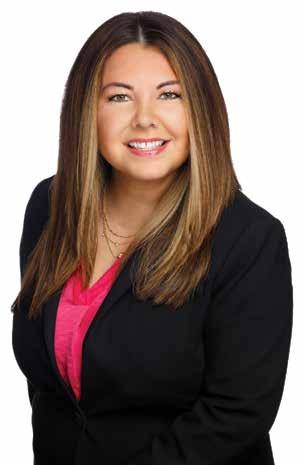
Cardiologist,










Whether competing to be one of only eleven orthopaedic Centers of Excellence in the country, or cheering alongside the Mizzou Tigers as their team physicians, our sports medicine experts know what it takes to level up, day in and day out. From our walk-in injury clinics to the latest treatments and training programs, we’ve got everything Missouri athletes need to be, and stay, at their best.




Best Overall: Girard Homes
6517 Portcrawl Dr, Columbia
Curb Appeal: Anderson Homes 7510 Kirby Knowles Ct, Columbia
Best Kitchen: Girard Homes 6517 Portcrawl Dr, Columbia
Best Bath: Girard Homes 6517 Portcrawl Dr, Columbia
Outstanding Feature: Girard Homes 6517 Portcrawl Dr, Columbia

Best Overall: Hemme Construction
6501 Cromford Ln, Columbia
Curb Appeal: Hemme Construction 6501 Cromford Ln, Columbia
Best Kitchen: Hemme Construction 6501 Cromford Ln, Columbia
Best Bath: Hemme Construction 6501 Cromford Ln, Columbia
Outstanding Feature: Hemme Construction 6501 Cromford Ln, Columbia

Best Overall: Hansman Custom Homes
502 Bandon Dunes Ct, Columbia
Curb Appeal : Hansman Custom Homes
502 Bandon Dunes Ct, Columbia
Best Kitchen : Hansman Custom Homes
502 Bandon Dunes Ct, Columbia
Best Bath : Hansman Custom Homes
502 Bandon Dunes Ct, Columbia
Outstanding Feature : Hansman Custom Homes
502 Bandon Dunes Ct, Columbia
Best Overall: Anderson Homes
108 Walton Heath Ct. Columbia
Curb Appeal: Anderson Homes 108 Walton Heath Ct. Columbia
Best Kitchen: Anderson Homes 108 Walton Heath Ct. Columbia
Best Bath: Lombardo Homes
5760 Kingfisher Dr, Ashland
Outstanding Feature: Lombardo Homes
5760 Kingfisher Dr, Ashland




When dads are involved in their children’s lives ...



Discover how Good Dads is empowering, resourcing and encouraging fathers throughout Columbia and Central Missouri.

FATHERS PERFORM BETTER AT WORK AND CONTRIBUTE TO A ROBUST JOB FORCE

MEN HAVE WHAT THEY NEED TO FOSTER HEALTHY RELATIONSHIPS

FATHERS ARE MORE LIKELY TO PAY CHILD SUPPORT

CHILDREN HAVE BETTER TEST SCORES AND IMPROVED ATTENDANCE AT SCHOOL
We take pride in representing our community well and we couldn’t do what we do without our COMO Magazine advisory board. Thank You!






Beth Bramstedt
Church Life Pastor Christian Fellowship Church
Heather Brown
Strategic Partnership Officer Harry S Truman VA Hospital
Nickie Davis
Executive Director The District, Downtown CID
Sam Fleury
Assistant Vice President Strategic Communications, Columbia College
Chris Horn
Sr. Reinsurance Manager American Family Insurance




Kris Husted
Investigative Editor NPR Midwest Newsroom
Amanda Jacobs Owner
Jacobs Property Management
Megan Steen Chief Operating Officer, Central Region Burrell Behavioral Health
Nathan Todd Business Services Specialist First State Community Bank

Wende Wagner
Director of Resource Development
The Boys and Girls Club of the Columbia Area
Jeremiah Hunter
Assistant Police Chief & Commander Investigations Bureau Columbia Police Department
Have a story idea, feedback, or a general inquiry? Email our editor at Jodie@comocompanies.com.
EDITORIAL
Jodie Jackson Jr, Editor Jodie@comocompanies.com
Kelsey Winkeljohn, Associate Editor Kelsey@comocompanies.com
DESIGN
Jordan Watts, Senior Designer Jordan@comocompanies.com
MARKETING
Charles Bruce, Director of Client Relations Charles@comocompanies.com
J.J. Carlson, Director of Web Development
Sarah Swartz, Marketing Representative SSwartz@comocompanies.com
CONTRIBUTING PHOTOGRAPHERS
Sunitha Bosecker, Lana Eklund, Anthony Jinson, Caroline Roush
CONTRIBUTING WRITERS
Sunitha Bosecker, Beth Bramstedt, Barbara Bu aloe, Mitzi Clayton, Caroline Dohack, Mary Kate Hafner, Sarah Joplin, Hoss Koetting, McKenna Stumph, Michelle Terhune, Kelsey Winkeljohn
SUBSCRIPTIONS
Magazines are $5.95 an issue. Subscription rate is $54 for 12 issues for one year or $89 for 24 issues for two years. Subscribe at comomag.com or by phone. COMO Magazine is published monthly by e COMO Companies.
OUR MISSION STATEMENT
COMO Magazine and comomag.com strive to inspire, educate, and entertain the citizens of Columbia with quality, relevant content that re ects Columbia’s business environment, lifestyle, and community spirit.
Copyright e COMO Companies, 2024 All rights reserved. Reproduction or use of any editorial or graphic content without the express written permission of the publisher is prohibited.
CONTACT e COMO Companies 404 Portland, Columbia, MO 65201 (573) 499-1830 comobusinesstimes.com















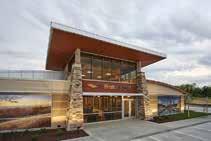

The Anderson Homes Foundation’s ‘My First Home’ initiative opens doors for first-time homeowners.
The 'We Always Swing’ Jazz Series is back for its 30th anniversary.
BY CAROLINE DOHACK
Should you ever have occasion to ask Jon Poses about jazz, be aware you’re about to open some oodgates. Poses, the founder, executive director, and artistic director of the ”We Always Swing” Jazz Series, possesses an encyclopedic knowledge of and unbridled enthusiasm for the genre.
He’ll get into the nuances of everything from big band to bebop, and you’ll nd yourself deeply invested — even if you were initially intimidated by that inherent jazz-guy geekiness. at’s because Poses is a raconteur with a gift for weaving context and side stories into a compelling and cohesive narrative. He loves this stu , and he hopes he can help more people cultivate an appreciation for it. And interestingly enough, it’s Poses’ positioning as a storyteller that led to the creation of the Jazz Series, which celebrates its thirtieth season this year.
Poses came to Columbia from New York City in 1978 to pursue a master’s degree in journalism at the University of Missouri School of Journalism. Finding the cadence of the daily news cycle limiting the kind of writing he enjoyed, he started pitching longform features about music and other subjects to magazines.
Later, when Bill Sheals and Gary Moore, who in 1985 had just purchased Murry’s, asked if any of the musicians he’d interviewed might be interested in playing at the restaurant, Poses had the perfect pick: New York-based, nationally known pianist James Williams.
Apparently, the show went really well.
“Almost immediately after James returned to New York, my phone started ringing. Musicians — well-known musicians who I had seen perform — said, ‘James Williams gave me your number and said you have this place, and you do jazz,’” Poses said, correcting the artists that it wasn’t his place.
Word got around that Murry’s was the place to play. As a result, for the next decade Poses, at Sheals’ and Moore’s behest, booked a mix of local, regional and, about once a month, national talent to perform on Saturday nights. To make the economics of bringing national talent to Columbia feasible, Poses began organizing multi-city tours for such artists so that Murry’s could be one of several stops. Poses had become a de facto music agent.
“I never intended to hang a shingle and say, ‘I have an agency and I represent so and so and so and so,” Poses explained. “But I would be on the phone six or seven hours a day booking twenty-city tours.”
But by 1994, there was a shift in the Saturday-night vibe. Murry’s was becoming more popular — especially with college football fans — and the jazz crowd’s practice of arriving two to three hours early to snag tables close to the musicians was eating into the restaurant’s turnover. And then there was the somewhat awk-
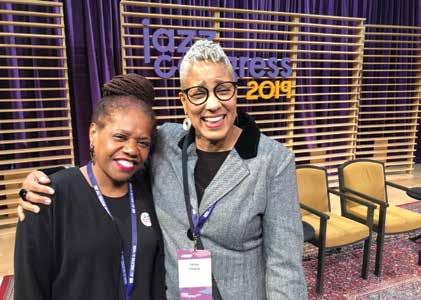
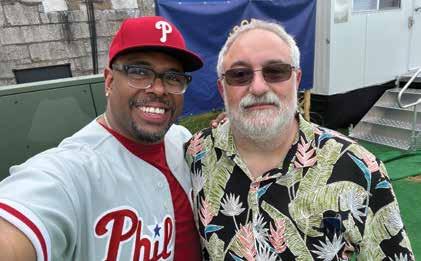
TOP: Impeccable vocalists Rene Marie and Catherine Russell are frequent We Always Swing performers. Rene Marie returns to Murry's on February 2, 2025.
BOTTOM: Jazz artist Christian McBride with Jon Poses at the 2023 Newport Jazz Festival.
ward practice of approaching each table to ask the patrons if they were staying for the music and, if so, to collect a cover charge.
“Gary, Billy, and I had a sit down and I said, ‘ e last thing I want to do is have Murry’s go out of business because of jazz.’ We agreed the Saturday night formula had run its course. It was no longer be viable.” Sharing that re ection, Poses said he considered returning to New York City.
“I felt I had done all I had to do jazz-wise in Columbia,” he said. “But somewhere in my brain, I wondered if people would buy tickets to a series of concerts.”
Poses prodded to the people on his mailing list — which had swelled to 300 names and addresses by that point — and asked if there would be any interest in purchasing season tickets to jazz shows.
“Everybody said it was a great idea,” Poses recalled. “Yes. Yes. Yes!”
He got to work and booked a six-concert series running from fall 1994 to spring 1995, announcing the concerts in July. Alas, the reaction Poses got when he pitched his idea didn’t translate to ticket sales. at rst season, thirteen people bought tickets to all six concerts — a grand total of seventy-eight tickets.
“It’s always been a slow build,” Poses said, noting that the distinctly American sound has rarely received the fanfare given to oth-


er styles. “Jazz is not taught in the schools. Now, it’s not heard on the radio as much. It’s not seen on TV. ere’s only one genre that does not have a national award show.”
And that’s a big part of what fuels Poses’ ambition to expose more people to jazz. As he insists, jazz can be framed as a sociopolitical discussion. Early jazz bands were some of the rst to bring together Black and white musicians. And the very nature of jazz invites — or even demands — that the individual add some element of themself to the music.
“Jazz owns a uid and dynamic movement,” Poses added. “It’s not static. One of the main tenets is improvisation. What I tell people is in classical music, you‘re judged by how closely you’ve come to playing the music the way Mozart intended it to be played. Jazz is not the opposite, but it’s di erent. Okay, Duke Ellington presented ‘Take the A Train.’ His orchestra played it so well, who wants to hear other versions of ‘Take the A Train’ unless you’re going to add something to the mix? Unless you’re going to interpret it and make it your own? Jazz is about having your own voice and creating.”
But even a slow build takes form over time. After a few years of nancial ops — with Poses at one point bankrolling a signi cant chunk of the operations largely using his tour commissions — the series, having attained nonpro t status in 1999, became eligible for grants, gifts from foundations, and sponsorships as well as allowing donors to take a tax-deduction for contributions. Today, Poses said, the organization’s annual budget — having grown from the initial $30,000 to $375,000 in scal year ‘25 — is divided almost evenly among grants, foundations, and sponsorships; individual gifts; and ticket sales.
e increased budget has resulted in the Jazz Series exponentially increasing its o erings. In addition to subscription concerts, which now number between ten and thirteen annually, the organization, in partnerships with Columbia Public School District and MU School of Music, produces several in-school educational and community outreach programs throughout the year; and the Von Freeman Memorial Lending Library, housed at the Jazz Series’ o ces at 21 N. Tenth St. holds more than 9,000 CD and LP recordings.
ose with library memberships can check out albums on a weekly basis, while everyone is invited to stop by and listen to selections on site.
But, of course, there’s nothing like live music, and for its thirtieth anniversary, We Always Swing is presenting a homecoming of sorts.
“It was a high bar we set, and we came pretty darn close to scoring everything we wanted to,” Poses said. “ is year, we wanted to do a retrospective and have a number of musicians who have been here — some who were here recently and some who haven’t been here in twenty years or more.”
It’s a mix of jazz veterans like Grammy-nominated vocalist René Marie, drummer Matt Wilson’s Good Trouble, and saxophonist Vincent Herring’s Something Else! group, as well as up-and-comers like trombonist Nick Finzer and pianist Emmet Cohen.


One beloved Jazz Series tradition is the Dr. Carlos and Laura Perez-Mesa Memorial Concert, which honors the memories of two local arts patrons. Since 2000, as a nod to Carlos Perez-Mesa’s Cuban heritage, the annual concert shines a light on native Cuban jazz musicians. is season, on March 20, 2025, the all-Cuban Hilario Durán Quartet takes the stage at the Missouri eatre.
All told, it looks like this season will be a nice chapter in the story of the “We Always Swing” Concert Series.
And local concert goers might spot a few familiar faces when the renowned saxophonist Bobby Watson takes on the role of conducting the eighteen-piece Columbia Jazz Orchestra, that will perform an all-Watson-composed repertoire.
TOP: Arturo O'Farrill captures the energy during one of his annual kids concerts at Hickman High School.
MIDDLE: The trio of Bruce Barth, Anat Cohen, and Steve Wilson perform for the inaugural "We Always Swing" Jazz Foundation fundraiser.
BOTTOM: The Maria Schneider Orchestra performs in February 2024 at the Missouri Theatre.





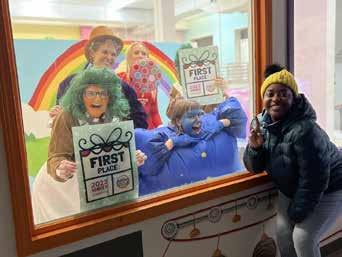
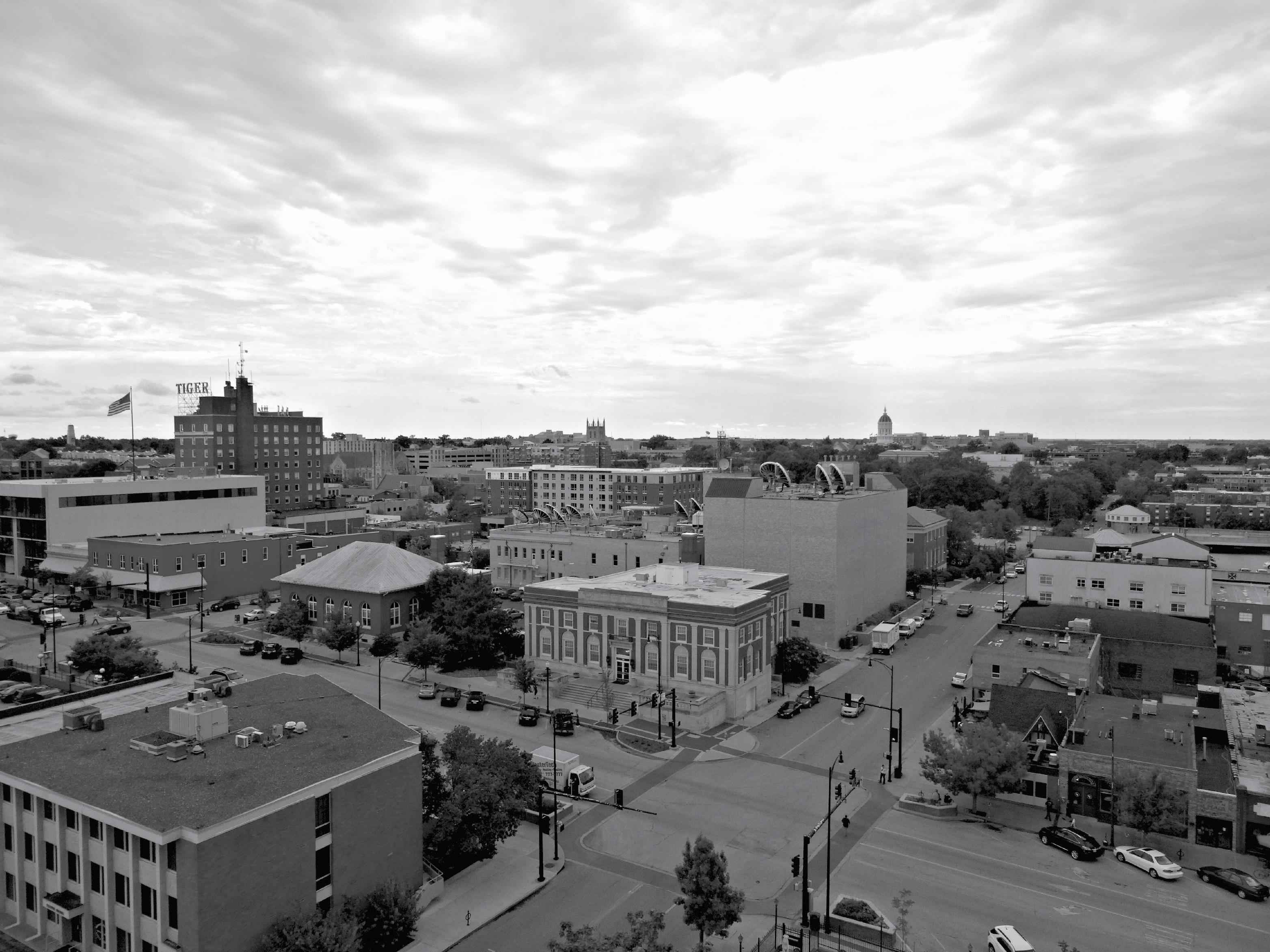
BY MARY KATE HAFNER
Visiting a grocery store is an everyday activity many people do without a second thought. ey open doors and pick out produce, and they do so without being overwhelmed. But that is not the reality for every person. Some folks need a helping hand or, in some cases, a helping paw.
Retrieving Freedom is a service dog organization providing support to veterans with mental or physical disabilities as well as children with autism.
“Anybody that has ever owned a dog has an understanding of their natural ability to recognize our emotions. Our dogs know when we’re happy, and our dogs know when we’re sad,” said Brandon Butler, the chief executive o cer of Retrieving Freedom’s Missouri facility. “What we’re able to do through our scienti c training program is harness the dog’s natural abilities for good.”
Butler was motivated to join Retrieving Freedom after visiting its Missouri facility in Sedalia. ere, he met 75-year-old Vietnam veteran Ivan and his wife, Mary Jo. e couple was in residence training with their new service dog. Ivan su ers from post-traumatic stress disorder (PTSD), one of the most prevalent mental disorders among U.S. veterans. Mary Jo had served as Ivan’s caretaker for more than forty years, which was taxing on their lives. e assistance of a service dog allowed Ivan to reclaim independence and autonomy, and enabled Mary Jo to relax and enjoy her life, knowing Ivan was taken care of.
While the overlap between veterans with PTSD and autistic children is not apparent, there are many overlapping symptoms, including anxiety, are-ups, and anger ts. Service dogs can recognize those triggers and soothe their owners by applying different levels of pressure. at pressure re-



leases happy hormones and lowers stress, which can help owners navigate their lives. Retrieving Freedom service dogs can physically assist with twenty-eight actions, such as pulling wheelchairs, pushing plates to open doors, turning o and on light switches, and even picking up credit cards from concrete.
e U.S. Department of Veterans Affairs (VA) noted that the risk of suicide is almost 72 percent greater in the veteran adult population than that of non-veteran adults. Missouri consistently tops the list of veteran suicide rates. Butler said that many veteran clients come to Retrieving Freedom as a last resort, but the service dogs give them new purpose. Every veteran placed with a Retrieving Freedom service dog is still alive today.
Much like Mary Jo, parents of autistic children regain parts of their own lives with the security of a service dog. Eloping, where a child will abruptly depart — such as running across a busy street without checking tra c — is a common fright for autistic children’s parents. A service dog, tethered to a child, acts as an anchor to prevent the child from running into harm.
It takes two years and an investment of $50,000 to train one of Retrieving Free-

dom’s service dogs. Retrieving Freedom starts training before a dog is born with its in-house breeding program, ensuring the dogs have the correct temperament for the job ahead.
One hundred percent of the cost of the dog and living accommodations during training are free to veterans. Retrieving Freedom is chie y funded by private donations, including individual donors and corporate sponsors. e VA also helps cover some expenses. To receive VA support, Retrieving Freedom must maintain an accreditation from Assistant Dogs International.
“If there is anything we need help with right now, it is nding more foster families and more foster opportunities for our puppies,” Butler said.
Puppies in service training need to be housed somewhere and be taken to monthly classes. Butler has found great collaboration with the elderly community that may want companionship but cannot commit to a decade-long relationship with an animal.
“Be part of a process that ultimately changes people’s lives. You and this dog are providing integral aspects of this program to help ultimately change or save a life,” said Butler.


‘Team effort’ charts success, increased call volume for suicide prevention network.
BY M C KENNA STUMPH
Teamwork and partnerships are behind the success of the 988 National Suicide Prevention Lifeline, which recently marked its second anniversary.
“It was a team e ort. A huge team effort,” said Carisa Kessler, director of crisis services for Burrell Behavioral Health in Columbia. Burrell is among six Missouri call centers where 988 calls are directed based on area codes.
Kessler credits national, state, and local partners for starting the local 988 call center.
“Multiple agencies and individuals coming together with the same vision is ultimately what led to the successful implementation and continued success of 988,” Kessler added.
e 988 Lifeline is a national network of local crisis centers that provides free and con dential emotional support to people who are in a state of suicidal emergency or emotional distress. e lifeline o ers support twenty-four hours a day, seven days a week, with calls answered by or directed at trained professionals who can help individuals having a mental health crisis.
Since the start of the original National Suicide Prevention hotline in 2004, e orts have focused on making mental health services more readily accessible to individuals in crisis. One result of that emphasis was changing the number to 988, which allows for text messaging communications.
e Missouri Department of Mental Health is the 988 lifeline administrator in Missouri. Several funding streams are used to support 988 in Missouri, including federal block grants, federal 988 grants, and state general revenue funding.
For sta ng the centers, each certied answering center is responsible for sta ng its center. To ensure the calls are answered at all hours and that the center has enough trained crisis specialists available to take the calls, the call volume is closely monitored. Callers are also assessed to determine if they will have follow-up needs that can be addressed.
e crisis line data show an increase in calls since January 2023, when 229 of the 435 calls were from individuals in crisis. At that time, crisis specialists answered calls with ten seconds, on aver-
age, and spent an average of eleven minutes talking with the caller. e answer rate — the number of calls answered out of all incoming calls — was 95 percent in January 2023. O cials said the answer rate also includes calls that callers abandoned before being answered.
By comparison, there were 560 calls to the local crisis line in January 2024, and 402 were from callers having a mental health crisis. e data showed that crisis specialists answered calls within nine seconds, on average, and they spent an average of 15 minutes talking with the caller. e answer rate was 93 percent.
“We have seen an increase in calls since 988 rolled out,” Kessler said, noting that continuing to educate local communities and bringing awareness about 988 is a major contributing factor to the call volume increase.
“Once individuals realize the support and assistance received by utilizing 988, they are more inclined to not only call again but encourage those around them to call as well,” she added.
ere are multiple ways to contact 988: Via call, text, and chat. ere are also resources for speci c groups and individuals, including individuals with neurodivergence, mental health for speci c ethnic groups, maternal mental health, youth, disaster survivors, Native Americans, veterans/service members, loss survivors, LGBTQ, suicide attempt survivors, and deaf and hearing-impaired individuals.
e 988 rollout has allowed mental health providers to reshape how they deliver crisis services. Now, in addition to the lifeline, the mental health landscape follows “a crisis continuum,” which includes the hotline, a mobile response option, and behavioral health crisis centers, such as Burrell.
e mobile crisis response was created to make services available to individuals experiencing a behavioral health crisis, whether in their home, workplace, or another community-based location. e two-person team, which is made up of a mobile crisis specialist and a certi ed mobile peer specialist, may also provide a response via telehealth.
STORY AND PHOTOS BY SUNITHA BOSECKER
There’s a moment when you sit in front of a pottery wheel, feeling its cool metal surface under your ngers, and realize you’re about to create something from nothing. For someone like me, and perhaps most of us, we want to do things well the rst time. But clay wheel throwing isn’t something you can master with copious notes or meticulous observation. It’s a craft that demands your presence, a skill that grows as you allow your hands to lead the way rather than your mind.
And that’s the beauty of stepping out of your comfort zone — it forces you to get creative, to let go, and to discover new parts of yourself.
I decided to take the plunge with a six-week ceramics class at Access Arts, a local nonpro t in Columbia that has been fostering creativity and community. Under the gentle guidance of instructors like Sophie Lever, an artist-in-residence passionate about teaching, I began my journey with wheel throwing.
Stepping into the ceramics studio, I felt an anxious and exciting energy. As Sophie instructed during the rst session, “You can’t control the clay. It will do what it wants. You have to feel your way through it.” Her words stuck with me, like a reminder that art — and maybe life — requires a certain level of surrender.
In the rst few rounds of shaping the clay, I caught myself gripping it too tightly, trying to force it into something it wasn’t ready to become. e wheel spun underneath my hands, the wet clay wobbling unpredictably, resisting my attempts to tame it.
“Don’t ght it,” Sophie would say, her voice encouraging. “Let it guide you.”
People can enter a strange, almost meditative state when working with clay. e more I focused on letting go — of controlling every movement, every outcome — the better the experience became. Classmates would agree, “Just enjoy the clay and have fun.” And strangely, the best results happened when I stopped trying to be perfect. Instead, I seemed to possess more childlike tendencies, where creation is pure joy, unburdened by critique.
At a couple of open studio sessions, I admired other students in the room who were designing beautiful bowls and cylinder vases. It’s hard to focus on your newcomer lane and be gentle about the devel-




opmental process when others are mastering their skills. You must step back and appreciate the dedication to the practice, and you are simply a new student learning a new practice.
I found myself imagining the ancient pottery markets of Sri Lanka. Artisans spent their entire lives honing their craft, passing down knowledge through generations. I envisioned the vibrancy of the clay market stalls, each shop lled with pieces that told stories of commitment, community, and years of practice. I wondered if those potters, with all their skill, ever experienced the same satisfaction I felt when a lopsided bowl nally took shape.
e imperfections in my work felt like a re ection of my learning process, and I embraced them.
As the wheel spun, I noticed that my brain, once tangled with overthinking and self-criticism, started to quiet. e act of shaping clay was an escape from the usual distractions and noise of life. It was a revelation — the act of creating and just enjoying the present, especially something tactile and tangible, was a way of discovering new ways to be kinder to myself by letting things oat away.
On a less lofty level, the process of wheel throwing is undeniably messy. ere’s something deeply satisfying, though, about plunging your hands into the slick, cool clay, feeling it squish and mold between your ngers. It’s gross, sure, but it’s also an incredibly grounding experience. I would leave class with clay smudged on my clothes, under my nails, and in my hair, but each smear felt like a badge of honor, proof that I was learning by doing.
As Sarah Catlin, the executive director of Access Arts, told me, “It’s always rewarding to see people who say ‘I’m not good at art,’ and then they come to a class and make something incredible.”
at’s exactly what happened to me, but more on the amateur level. I’m not opening an Etsy shop anytime soon. By the end of each class, I would look down at my hands—stained with clay but also with newfound con dence. e more I let myself play, the more my creations started to resemble actual pottery.
One of the most valuable lessons I learned from Sophie and the team at Access Arts was how to x my mistakes with the understanding that mistakes are guaranteed. Like many supportive instructors, Sophie didn’t rush to correct me when I made an error. Instead, she allowed me to gure it out independently, giving just enough guidance to steer me back on track. “It’s not going to be easy,” she reminded us one evening. “No one is good right away. But that makes art exciting — it’s better to make something than nothing.”
ere were countless times when I thought I had ruined a piece — when the clay collapsed in on itself or wobbled out of shape. But each time, I learned something new about the material and about myself. Pottery teaches patience. e process forces a person to slow down and accept that not everything will go according to plan. And when it does go wrong, there is always a chance to start again, to reshape the clay, and to improve.
Access Arts has become a creative sanctuary for people looking to stretch beyond their usual boundaries. Founded in 1971
and gaining nonpro t status in 1974, it has grown into a space where aspiring and seasoned artists can explore their creativity through ceramics, weaving, spinning, and more. Sarah proudly spoke about the center’s work with military veterans and children at Benton Elementary through their free after-school art club.
“We want people to discover that they can create incredible things, no matter what they’ve been told,” she said.
Sophie’s residency at Access Arts was another element of the studio’s magic. She moved to Columbia earlier this year after completing a year-long artist-in-residency program in Brockway, Pennsylvania. Additionally, she practiced her ceramics skills at a community studio in New York while attending a college without a ceramics class. Her love for teaching was evident in working with the high schoolers in the after-school program and with adults like me. Each class was a mix of guided instruction and space to experiment, a balance that allowed for learning and creativity to ow naturally.
By the end of my six-week session, I made a few wonky bowls, a lopsided cup, and a misshapen plate. But more importantly, I found a new creative outlet that helped me step outside of my comfort zone and feel freedom, similar to those childhood craft times. It’s easy to get caught up in the details, in the need to create something perfect. When letting go of that pressure for perfectionism, you open yourself up to discoveries.
As Sophie said during our last class, “ e best advice I can give is to keep doing it. It’s better to make something than nothing.” I realized that her advice didn’t just apply to ceramics — it was a lesson for life. Whether you’re shaping clay or navigating a new direction, the key is to keep going, to embrace the mistakes, and to nd joy in the process.
If you’re looking to break out of your comfort zone, consider getting your hands dirty. You might just nd that the less you care about perfection, the more beautiful things you’ll create.
Check Access Art’s o ers on its website, including weekly adult ceramics classes, weekly bers classes, and date nights. Registration for the November/December class series are open — and they will ll up quickly.


Where can we find peace when our world is unraveling?
BY BETH BRAMSTEDT
It was July of 1993. I was pregnant with our rst child, getting large and bored as I inched toward my third trimester. Yet while I was worried about what was going on inside me, many others were worried about what was going on around me.
In the Midwestern United States, along the Mississippi and Missouri rivers and their tributaries, what would be known as the Great Flood of 1993 was beginning to show its face. Land across the area saturated by June, with additional rainfall running o into streams and rivers, rather than soaking into the ground.
Meanwhile, I was on bed rest and getting quite antsy. By mid-July, I begged my husband to show me the damage. We hopped in the car, got on I-70 (which was still open at this point), and headed toward Boonville. We found a place to park and walked along the Boonville Bridge, sweating as we inspected the roaring waters and demolished structures.
A few days later, the bridge was no longer crossable, and my baby was no longer safe in my womb – and his due date was still more than six weeks away. Nature was not cooperating in so many ways!
To say my life felt unsettled would be an understatement. My life was thrown into chaos and confusion. I had no control over what was happening. My world was shaken. Most of us can remember feeling similar. Whether it was a natural disaster, a personal matter, or a political one, our kingdoms have been shaken. A tornado, a divorce, the onset of war, can turn our worlds upside down. We all know where we were and what we were feeling on 9/11. And today is no exception. Depending on your political views and what you wanted to happen or not happen in this election, your life may feel like it is unraveling. Where can we nd peace when our world is shaken?

My life has found its footing, its grounding, since metabolizing this quote from author and spiritual director James Bryan Smith. He writes:
“You are one in whom Christ delights and dwells. You live in the strong and unshakeable Kingdom of God. His Kingdom is not in trouble, and neither are you.”
Really?! No matter what, God delights in me. I am His. I am adopted into His royal family. His kingdom is not in trouble, so why am I worried?
is quote comes from Hebrews 12:28.
“Do you see what we’ve got? An unshakable kingdom! And do you see how thankful we must be? Not only thankful, but brimming with worship, deeply reverent before God.”
What if we change our perspective?
What if we took our feelings or anxiety, restlessness, and confusion and turned them to gratitude? What if we took our an-
ger and dread and reframed it as worship to our God?
What would it really look like to live in the truth that God’s Kingdom is unshakeable? at God is in Heaven, looking deep in your eyes, and saying, “Don’t worry, I’ve got this.”
Isaiah 41:10 reminds us:
“Don’t be afraid, for I am with you. Don’t be discouraged, for I am your God. I will strengthen you and help you. I will hold you up with my victorious right hand.”
He’s got this.

Beth Bramstedt is the Church Life Pastor at Christian Fellowship.
BY BARBARA BUFFALOE
The season of gratitude and re ection will soon be upon us. It’s a time when many of us look for ways to give back, uplift others, and, as the theme of this month’s magazine suggests, “Do good.” While there are many ways to perform acts of kindness, I’d like to highlight a speci c path to making a di erence in peoples’ lives: Authentic leadership.
Leadership isn’t about a title or a position. It’s not reserved for people with an o ce in City Hall or an executive suite. Leadership is about the ability to in uence and to serve as an example to others, whether in our communities, our families, or our workplaces. It is about cultivating a mindset of positive change, instead of settling for or complaining about the status quo. I believe that leadership begins by asking, “What can I do to help?”
Being an authentic leader means showing up as your true self — embracing your strengths, admitting your limitations, and acting with integrity. Authenticity fosters trust and genuine connections, allowing people to feel seen and valued. An authentic leader will be the rst to admit they do not have all the answers but should strive to nd solutions by collaborating with others. When we lead authentically, we inspire others to bring their whole selves to the table, creating a ripple e ect of honesty and collaboration.
Serving as mayor, I hear from people who are passionate about making Columbia a better place, and I listen as they describe the challenges that they

encounter as they try to create lasting change. While it’s easy to point out problems that we face, like climate change, affordable housing, and unequal access to upward mobility, it is much harder to become part of the solution. at is where authentic leadership becomes critical.
Columbia has a long history of citizens stepping up to provide that leadership and I’d like to highlight two past mayors. First, Mayor Darwin Hindman was a prime example of authentic leadership. His genuine passion for enhancing the quality of life in the community was evident throughout his tenure. Hindman was a relentless advocate for active transportation, dedicating much of his time to making Columbia more walkable and bike-friendly. Hindman’s authenticity came through in his handson approach — he was known to bike around the city, embodying the values he championed. His deep commitment to the environment, healthy living, and community well-being was not just a political stance; it was a re ection of who he truly was.
Second, Mary Anne McCollum, Columbia’s rst female mayor, also exempli ed authentic leadership through her compassionate and community-centered approach. During her time in ofce, McCollum worked to strengthen community partnerships and enhance
social services, particularly for housing. Her authenticity was rooted in her belief that leadership meant being a voice for the entire community, not just a select few. McCollum’s leadership style was characterized by humility, empathy, and a deep sense of responsibility.
Often, the answer to a problem is not easy to come by. In my experience, the most e ective leaders practice empathy and humility. ey take a genuine interest in other peoples’ problems, and they acknowledge that they don’t have all the answers. When I approach a problem as mayor, I pull together people with the kind of expertise and lived experience needed to nd an answer. In the end, it’s not about personal recognition or getting my way – it’s about putting the spotlight on the solution.
Doing good shouldn’t be a theme of the month, but a way of life. Let’s continue to lead with authenticity, kindness, and a shared commitment to building a Columbia that’s the best place for everyone to live, work, learn, and play.

Barbara Bu aloe currently is serving her rst term in o ce as the mayor of Columbia.
BY MITZI CLAYTON
At Heart of Missouri United Way, our mission is simple yet powerful — to improve the quality of life for every individual and family in our region, ensuring that every dollar contributed is maximized to its fullest potential. As the current chair of the Board of Directors at Heart of Missouri United Way, I am honored to witness rsthand how our community’s generosity is transforming lives across Boone, Cooper, and Howard counties. With 98 percent of United Way’s revenue coming from local community support, we work hard to ensure the funds we raise are invested locally, creating lasting impact in addressing the greatest disparities.
At Heart of Missouri United Way, our work is continuous. roughout the year, our team raises funds to support Community Impact Investment grants, which go to local health, education, and nancial stability programs. Our United Way team annually collaborates with community leaders to identify common goals for these impact areas that ensure these grants are tailored to our region’s needs.
e heart of our impact lies in the threeyear funding cycle we employ for each focus area. Currently, we are funding programs in Health & Basic Needs for 2024-2026, Financial Stability for 20232025, and Education for 2022-2024. We are currently reviewing proposals for new grants in Education that will begin in 2025. is staggered approach allows us to provide consistent support to organizations over an extended period, fostering long-term stability and growth.
In collaboration with the city of Columbia and Boone County, we aim to identify common outcomes and direct

the focus of the community toward hitting these targets. Once we establish the targets for a particular impact area, we release an Open Letter of Intent inviting organizations to submit pre-applications for grant funding. During this period, we also recruit volunteers for the Advisory Council, a group of local experts and community members who help guide the funding process. e Advisory Council reviews and scores each grant application, visits the organizations seeking funding, and makes recommendations to the board on the best way to invest the funds we’ve raised. Following a thorough presentation and discussion, the board votes on the request.
After the Board’s approval, we notify all applicants and make a public announcement on LIVE UNITED Day. at day for this year is November 21. Funding begins the following January, giving our team time to work with each organization to create Strategic Investment Agreements that clear goals, outcomes, and expectations.
As stewards of the community’s donations, we take our responsibility seriously. e above description is an abbreviat-
ed version of a process designed to have the greatest impact with the dollars received through community donations. is process requires more than 1,400 sta and volunteer hours annually and includes a speci c certi cation team to ensure rigor. Every organization that receives funding must provide annual reporting data to show they are meeting the goals outlined in their Strategic Investment Agreements. is ensures accountability and helps us track the impact of the programs we support.
It’s through this approach that Heart of Missouri United Way can fund services that support more than 33,000 people (1 in 5) in our community. However, none of it would be possible without everyone who contributes to Heart of Missouri United Way. Your support is not just a donation — it is an investment in the health, education, and nancial stability of our neighbors. rough this process, I believe we are uniting our community in purpose, action, impact, and hope!

Mitzi Clayton is the Director of Community Relations at Heart of Missouri United Way.
BY M C KENNA STUMPH
The yard at the Ronald McDonald House is large and has little trafc noise, even though it now sits at the busy intersection of College Avenue and Stadium Boulevard. Encased by towering trees, the new building at 1110 S. College Ave. provides pediatric patient families a sense of normalcy.
“It's amazing to me that this is a really busy intersection at Stadium and College, but it just feels like you just step away from everything. In the summer, it's really amazing back here,” said Terri Gray, as she points to the sweeping back deck. Gray has been the CEO of Ronald McDonald House Charities (RMHC) of Mid-Missouri since 2013. In the coming spring, RMHC will add four raised garden beds and start growing vegetables in part of the space.
“It could be therapeutic for families or a great opportunity for volunteers, and it gives them fresh produce,” she explained.
The Hearth Room is a large living room space, complete with comfortable
seating from RMHC’s national partnership with La-Z-Boy, which furnishes all of the soft seating for the house. Off the Hearth Room is the expansive back deck, overlooking the manicured landscaping and overarching trees.
“ is is my favorite space. It's really lovely in the mornings and evenings,” Gray added. “ e nice big yard and chunky squirrels give a sense of normalcy for the families staying.”
e new house, completed in June 2024, is about twice the size of the previous Ronald McDonald House at 3501 Lansing Avenue. e number of private guest rooms has expanded from eighteen to twenty-four. With parts of the basement left un nished, it has the capacity to add another eleven rooms, if needed.
e nonpro t’s board made adjustments to the new house based on feedback from guests staying in the previous house. e added workout room is Mizzou themed, with former Mizzou football coach Gary Pinkel providing the funding

to buy all of the equipment. It is out tted with elliptical machines, stationary bikes, a rowing machine, treadmills, and some of Pinkel’s favorite quotes.
“Families in the old house always asked for a TV in their guest room and a place to work out,” Gray explained. “So, when building the new house, Ronald McDonald House Charities made sure to provide those things.”
Each guest room resembles a hotel room and is now equipped with its own television, and some rooms are tted with bathtubs instead of showers in the private bathrooms. Fourteen days is the average stay. Some families will stay for much longer and others stay for just a night or two. e house provides all the amenities of a home, laundry facilities, and a fully stocked kitchen, where families can make their own meals. Other amenities include an abundance of McDonald’s coffee, and spaces where guests can hang out and read a book, chat with a friend, or just watch television.

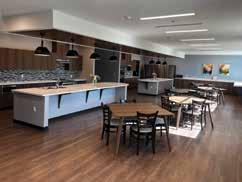
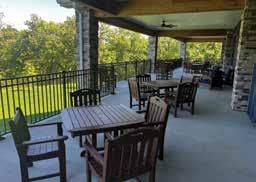
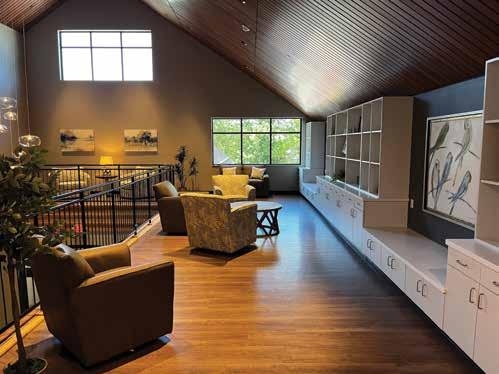
e new kitchen is about twice the size of the previous kitchen and fully modernized. Volunteer groups come in every night to cook a hot meal for families returning late from the hospital or day of appointments.
“It's really important to the families to have their own private space, but also to have community spaces where they can get to know other families who are going through similar situations,” Gray said. “It becomes a built-in support network. We just had a family check-out today that had been with us for 180 days. Not every story ends well, as you might imagine.”
At the entrance is a room labeled Sasha’s Store, which memorializes a piece of RMHC’s history. It was started at the previous house in a small alcove under a staircase as a place for families to grab toys, gifts, books, baby items, clothing, and more. Bill and Harriet Yelon, the parents of Sasha Yelon, didn’t have a place to stay while their son was undergoing medical treatments, having to move from place to place. e 7-year-old died in August 1990. His mother later served on the RMHC board and helped cut the ribbon to open Sasha’s Store.
“We were getting all these donations in, and we wanted a place for families to come and grab stu if they needed it,” Gray said. “We actually have a lot of siblings and patients who have their birthdays while they’re staying at the house or in the hospital, so parents can come in and grab toys and gifts. e room starts to ll up around the holidays.”
RMHC sta ers also use the donated items to give families staying in the guest rooms.
Fifteen to twenty percent of RMHC’s funding comes from McDonald’s restaurant support and programs. is year, the nonpro t will receive around $36,000 from Penny for a Pound of French fries. Other funding is from individuals, businesses, and four signature events — Red Shoe Gala, Fore the House Golf Tournament, a sporting clays tournament, and Brunch and Blingo.
Pediatric patients are 21 years old and younger, and they must have a referral from their physician, nurse, or social worker, and the family must also live outside of Boone County. If all of those conditions are met, a background check is run to ensure the safety of families at the communal living house. As long as their child is receiving treatment, parents and families are eligible to stay at the house.
“I think that is one of the cornerstones of the Ronald McDonald House, is having that built-in network, where you know you’re not alone in this journey,” Gray said.

Dear COMO Mag Readers, It’s a delight to hear from you each month with fresh and engaging questions about etiquette, navigating social norms, and blending tradition with modern trends. This month’s focus on Impact-driven individuals and organizations is one that I hold very near to my heart as a former nonprofit director for Columbia KLIFE and a current board member for True North. I work with some of our communities strongest nonprofits to plan their gala’s and large fundraisers and it’s a joy to see the impact that those events have not only for their organization but for our community as a whole. Thanks for submitting these questions and keep them coming in my social media inbox or email!
Dear Ashley,
Our non-profit hosts an annual gala, but this year we want to make it feel fresh and exciting. How can we keep the event from feeling like a repeat of past years?
- Ready for a Refresh
Dear Ready for a Refresh, It’s great that you’re looking to breathe new life into your gala! Here are a few ideas to make it stand out this year:
• Switch Up the Format: Instead of the traditional sit-down dinner, consider a more dynamic format like a cocktail-style reception or a themed experience. This keeps guests moving and engaged.
• Add a Unique Element: Whether it’s an unexpected performer, live art creation, or a new or out of the box venue, giving guests something different and memorable will elevate the experience.
• Infuse New Energy: Introduce a fresh theme or cause focus this year. Changing the narrative or featuring a new initiative keeps your regular attendees excited about supporting your work.
• Involve Guests: Get your audience involved with a meaningful activity where they can directly contribute to your mission.
Refreshing your gala doesn’t mean starting from scratch—it’s about adding new elements that create excitement and deepen your guests’ connection to your mission.
Dear Ashley, Our non-profit is planning a fundraiser, and we want it to be meaningful and impactful, not just another gala. How can we balance celebrating our mission with creating a memorable event?
- Purposeful Planner
Dear Purposeful Planner, Your event should reflect your non-profits mission at every turn. Here’s how:
• Tell Your Story: Use personal touches like videos or live testimonials to connect emotionally with your guests.
• Create Engagement: Offer interactive experiences that let attendees see your mission in action. Think hands-on activities or exhibits showcasing your work.
• Purposeful Design: Ensure your event reflects your values and is memorable, leaving guests wanting to come back for more.
• Unique Entertainment: Book entertainment that aligns with your cause, like performances from those you’ve impacted or a speaker with a similar mission.
• Celebrate Success: Take time to highlight your achievements and acknowledge supporters—it’ll inspire future donations.
At Delight Events, we love crafting events that tell your story and celebrate your cause.






DAVE PARSONS LEAD PROJECT MANAGER
By Dave Parsons dave@heartlandhomesmo.com
When considering home improvements, it’s essential to strike a balance between aesthetics, functionality, and property value. At Heartland Homes, we offer a range of services that not only enhance your home’s beauty but also provide long-term financial benefits. From roofing and siding to remodeling kitchens and basements, we help homeowners make smart, valueboosting investments.
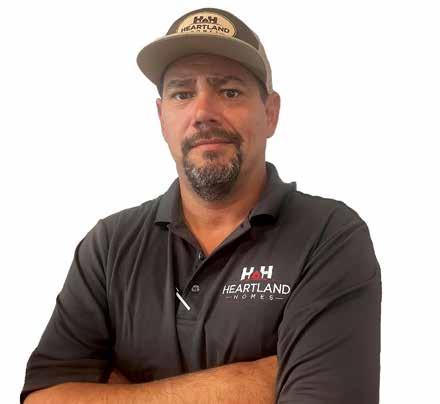
cooling costs, saving you money each month.
Having a high-quality roof is an investment that goes beyond safeguarding your home from the elements. It’s a critical factor in maintaining and increasing your home’s value. A well-maintained roof can also elevate your home’s appearance, giving it a fresh, polished look.
We specialize in assessing damage, including issues related to storm damage, and we work directly with insurance providers to maximize your coverage. With our expertise, you can rest easy knowing that your roof is in great hands, providing peace of mind and long-term savings.
High-quality siding acts as a shield against the weather, reducing air leaks and maintaining a stable temperature inside your home so that you and your family can comfortably enjoy every space. In addition to enhancing your home’s aesthetic appeal, quality siding results in lower heating and
Our siding services include a comprehensive inspection and a detailed cost estimate, so you’ll know exactly what to expect before we start any work. By working with us, you’re investing in the long-term durability and energy efficiency of your home.
Our remodels not only create stylish, functional spaces and enhance daily living but also increase the market value of your home. Let us assist you today with:
Dave Parsons is the lead project manager for interior remodeling at Heartland Homes, where he’s been for the last year and a half. However, his expertise in the remodeling field spans over 20 years, with a specialization in whole home remodels. Helping customers bring their ideas to life is his passion.


• Custom kitchen cabinetry and refinishing
• New flooring, custom built-ins, and fresh paint
• Vanities, countertops, showers, baths, and more!
Remodels that add usable square footage, such as finishing a basement or expanding a kitchen, directly increase your home’s livable space and overall value.
At Heartland Homes, we’re more than just home improvement experts—we’re your partners in making smart, financially sound decisions for your property. With services that focus on quality, value, and long-term savings, we’re here to help you enhance your home and protect your investment. Contact us today to schedule your free consultation and discover how we can turn your home improvement dreams into a financially rewarding reality.
By Austin and Lacie
Back in January 2024, we got this year started with a fun overview of how our team fosters employee engagement and nurtures leadership skills. We talked a little bit about how we focus on that work/life balance, which most companies talk about with mystical, far-out-there references.
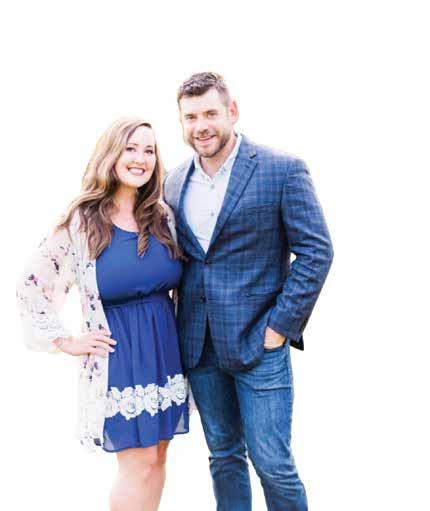
But as we approach the end of 2024, and during this special season of gratitude, we want to highlight some of the stories and interests to demonstrate how important work and life are to the Ai Painting Plus team. Giving back to the community and giving back to yourself by investing time and resources into the interests that bring you joy and make you complete are just a couple of the important values that are part of our business DNA.
For instance:
• Cameron Naugle, our project manager, puts creativity and time into model making and painting, as well as metalworking and forging. The top of his wish list? “Camping, fishing, and spending time with my wife and five cats.”
• Trevor Judkins is our trainer and field supervisor. His interests closely resemble Cameron’s: making bows, camping, fishing, and spending time with his wife and dogs.
• Team leader Austin Isley is into golf, working out, camping, playing banjo and other instruments, and spending time with his wife Lacie, their two kids, three dogs, and a cat.
• Lacie Isley is all about building the team and energizing Ai Painting Plus, but she also carves out ample time for gardening, making sourdough bread, working out, cooking, camping, and spending time with family.
• The team’s chief color coordinator, Jaclyn Rogers, is all about working out, supporting Mizzou sports, and hanging out with her husband, son Zane, and pug Tank.
Let’s take this a step further and shine a quick light on how Austin, Lacie, and Jaclyn also invest in the Columbia community. Austin is on the Marick Dance board of directors, and Lacie is on the boards of the Better Business Bureau and Homebuyers Association. Jaclyn rounds out the list of civic involvement with leadership roles in BNI, the Women’s Network, and as a member of ACA.
Now for a brief recap of how company culture paints a grand canvas of employee success:
• The Ai Painting Plus vision is to be a place where people love to work with people they love working with while providing the highest level of customer service possible.
Austin Ilsley, co-owner started Ai Painting Plus in 2013. From the age of 16 he started working with other painting companies which gave him a solid foundation for performing the work and running a company dedicated to professionalism both with himself and his crew. In 2021, his wife Lacie Ilsley became the new Owner. Since the start of this company, she used her skills to grow the business and create an enviable company culture in the Columbia community.


• As our company grows, we want to provide our team members with a path to growth — professionally and personally. Our goal for growth isn’t just increased profits and sales, but more opportunities for our team members.
• We encourage our employees to paint a picture of what their future looks like. (Pun intended!) A lot of times, people don’t typically see past today, this week, or next week. But what does your future look like?
We’ve already said it, but it really does come down to this: When you invest in and care about people — when you do those things right because it’s just how you do business — your business will flourish. And so will all of your team members.
By Geoff Jones & Krista Shouse-Jones
Selling your home in the winter doesn’t have to be daunting! With the right strategy, you’ll still find success in the “off-months”. Follow these tips to help you navigate the winter market and find a buyer.
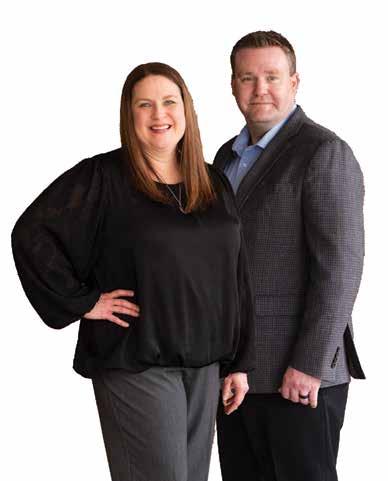
1. Showcase Your Home’s Warmth Winter is all about cozying up indoors. Make sure your home reflects that feeling.
• Create a welcoming atmosphere: Warm colors, soft lighting, and comfortable furniture can make your home feel inviting even on the coldest days.
• Keep it clean and clutter-free: A clean and organized home is more appealing to potential buyers.
2. Maximize Natural Light
During the winter, days are shorter and the sun can be scarce. Make the most of the natural light you have.
• Open the curtains: Let in as much natural light as possible, even on cloudy days. Dark, heavy window treatments should be removed.
• Light it up: Turn on all lights and lamps prior to showings, especially in the evening. If your home is dark, consider adding more light fixtures.
3. Stage for the Seasons Winter decorations can add a festive touch to your home, but it’s important to strike the right balance.
• Don’t overdo it: Too many decorations can make your home feel cluttered and distract
visitors from the positive qualities. Keep holiday-specific decorations to a minimum, as they could be off-putting to some buyers.
• Highlight winter’s beauty: Incorporate winter-themed elements like pine cones, candles, and cozy throws.
4. Price Your Home Correctly
Pricing your home correctly is essential for attracting buyers. The three main factors that influence sales are market conditions, the condition of the home, and price. A professional assessment will help you to determine an accurate listing price.
• Consider the season: Winter can be a slower market, so you may need to adjust your price accordingly.
• Condition can help bring a higher price: Think like a buyer! Imagine seeing your home for the first time. Would you be pleased with its condition? A fresh coat of paint and small repairs can make a big difference in creating a strong first impression for potential buyers.
• Work with a professional: A Realtor will share market trends and evaluate comparable properties on the market and recently sold. They will help you determine the optimal price for your home.
Geoff and Krista bring over 20 years of dedicated service as Columbia police officers to their real estate career, offering a unique and in-depth understanding of the local community. Their deep knowledge of Columbia’s neighborhoods and inner workings gives them an edge in guiding clients through the real estate process. Whether you’re buying your first home, transitioning to a new one, or investing in rental properties, Geoff and Krista are committed to helping you achieve your goals and secure a bright future in the community they’ve long been a part of.


5. Prepare for Showings
Showcase your home in its best light by ensuring potential buyers have a pleasant experience.
• Keep it safe: Clear snow and ice from your walkways and driveway.
• Keep it warm: Make sure your home is heated to a comfortable temperature before showings. If you have a fireplace, turn it on!
• Keep it tidy: Be prepared to accommodate showings on short notice by ensuring your home remains clean and show-ready.
The most important tip to keep in mind? Don’t brave the cold alone! Our experienced team at Bev & Co. Realty will help you strategize to meet your specific home-selling goals. With the right approach and the right Realtors at your side, you’ll be on track toward a successful winter home sale!
By Jacob Porter

Jacob comes from the small town of California, Missouri. With his plant science degree from MU and six years with Rost, he enjoys creating exciting outdoor spaces for his clients. Watching these creations come to life is only one highlight of being a designer for Rost. When he is not designing, he loves spending time with his wife and kids, tournament bass fishing, and doing a little bit of woodworking.
As you start to plan your outdoor spaces, it is fun to consider the features that you will see. The patios, pools, plantings, and the list goes on. As important it is to think about these features, it is equally important to keep in mind the ‘other’ considerations that are involved in the planning process. How water moves through the property, what areas get sunlight and when, and locations of utilities are all practical things that need to be thought about and planned for accordingly.
Drainage and how water moves through your property is one of the first things to take note of when you start your design process. If you are wanting any patios, you want to make sure there is enough elevation change that water can be drained off the patio and away from the house. There may be retaining walls that are needed to help address potential drainage issues. You may even need to consider underground drainage systems to help remove water from areas that don’t have enough slope to direct water correctly. The goal is to make sure as much water is draining away from the house as possible.
The location of sunlight throughout the day will affect how you plan your outdoor space. If the space you pick for your patio has a lot of afternoon sunlight, it would be good to consider some sort of shade structure or planting trees to help provide shade in the afternoon. If you have a pool, it is nice to have more sunlight for those tanning ledges or lounge areas on the patio. When you are planning out the plantings around your home, plants will have different light requirements. So, you’ll want to make sure the plant you choose for an area can tolerate the amount of sunlight it will receive.
On all properties, you’ll have utilities that will need to be worked around. These can include water, gas, electric, and communication lines. These utilities may be underground or overhead. As the outdoor spaces are planned, you’ll want to abide by local regulations they may dictate what can be done or where certain features will need to be located. Along with the utilities themselves, many may

have easements that have restrictions on what can be built within those easement boundaries. If you are unsure of where utilities are located, Missouri One Call can mark the public utilities for you. However, they may not mark the private utilities such as your irrigation system.
It is easy to get caught up in planning out the fun or aesthetically pleasing features of your outdoor spaces and what you’ll see on a day-to-day basis. But keep in mind, it is imperative to consider the water, sunlight, and utilities as you work on the design for your future projects. If you need assistance with these designs, contacting a trusted landscape company is a great place to start.
By Jeremy McKenzie tintbytoalsonllc@gmail.com
Many people are familiar with window tint on automobiles; however, we chose to specialize solely in residential and commercial applications. We provide services to large commercial projects such as school districts and hospitals as well as single windows in homes. By electing to only focus on architectural window tinting and not automobiles, Tint by Toalson offers superior workmanship in these settings.

Jeremy is a Columbia native who has lived many different places including abroad until finally making his way back home and purchasing Tint by Toalson in 2016. We continue with the small family-owned business mindset that made Toalson such a wellknown name in the Columbia community and always provide completely free estimates.

(573) 443-8468
Tintbytoalsonllc@gmail.com
When you’re creating privacy in an area of your home, decorative film is a great addition. Decorative film can give your windows the look of etched, frosted, and textured patterns like rain glass or fluted glass. This gives you the benefit of being able to change the aesthetics of the glass in your home without the need to replace it.
The opacity of these products ranges from lightly frosted to total light blocking. The most common areas in homes for decorative window film are bedrooms, bathrooms, and doors. When a light frost or opaque is used it will allow for complete privacy while not reducing the natural light. This is especially useful in areas such as front doors or large bathroom windows where blinds or window treatments are not practical or visually appealing.
There are several benefits to tinting your house windows.
Tinted windows can help reduce the amount of heat that enters your home. This can help keep your home more comfortable during the hot summer months, while also reducing your energy

bills. Additionally, tinted windows can also protect your furniture from fading, as they block out harmful UV rays.
Another benefit of tinted windows is increased privacy. Tinted windows make it harder for people to see into your home, which can make you feel more secure. This is especially beneficial if you live in a busy area or near a main road.
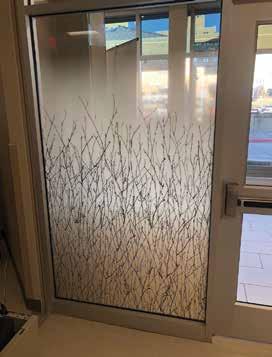
Lastly, tinted windows can also improve the appearance of your home. The tinted film can give your windows a sleek, modern look that can enhance the overall aesthetic of your home.
In conclusion, tinting your house windows can offer several benefits, including reduced heat, increased privacy, and protection from UV rays.










BY SARAH JOPLIN
If you are looking for more than your next good meal, be on the lookout for City of Refuge’s new food truck, City Cuisine Global Fusion, making its debut with soft openings and catering opportunities over the winter. e truck will most often be parked at 10 North Garth Avenue, the nonpro t’s headquarters that serves as a community center for hundreds of refugees from nearly forty countries who now call Columbia home.
Expect to be served by the new residents and enjoy a taste of their native cultures and hospitality.
Each semester, Columbia welcomes academics from around the world seeking new horizons but in recent years, the city has also embraced displaced individuals and families seeking a better life. What began in 2010 with a few locals being neighborly has grown to an organization of full-time sta and nearly 200 volunteers orchestrating connections to assistance programs that help address the basic needs as well as language, education and employment obstacles of Columbia’s new arrivals.
Debbie Beal, City of Refuge executive director, acknowledged that “food is a really important piece of culture and a way to communicate through barriers.” e food truck idea oated around City of Refuge until the organization was awarded a workforce empowerment grant allowing it to become a reality.
e menu will feature a hybrid of di erent avor pro les from around the world.
“We’re trying to get people to step out of their culinary comfort zone a little bit and try international cuisine,” Beal said.
Main dishes will run $12 each and include Southeast Asian-inspired beef bahn mi smash tacos, Middle Eastern jawenah grilled chicken salad or sandwiches, and tahini beef burritos. Za’tarspiced basmati rice will be among the side dishes that range from $3 to $4 each. Kids beef smash tacos with fries will be $5 and dessert of house made chai ice cream can round out a meal for $3.
“Depending on who is working in the truck, we are planning on having a rotating menu highlighting one of their recipes from their home country,” Beal added.
Beyond o ering a new meal venue for locals, Beal is eager for the public exposure and awareness that the food truck can raise.
“A lot of people don’t know that refugees exist in central Missouri so this new initiative can create a presence in the community to prompt people to ask questions about what City of Refuge is and the clientele we serve,” she said.
Whereas the food truck aims to address the needs of resettled refugees, most of the organization’s work centers around helping address the



“One thing about this
initiative
that
is really beautiful
is that we’re
getting to teach something but
we’re
also getting to learn something as well. In that exchange we are also able to share something with the broader community.”

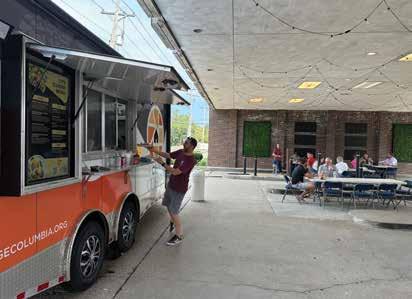
fundamentals of building a new life. at begins with the basic needs program that assists refugees in accessing food, clothing, housing, social bene ts, and medical aid. Programs fan out from there to include the “buddy program” for language tutorials, “homework helpers” once families have navigated school enrollment, a “youth impact” program for the teen population, and professional development that includes a “global artisans” program emphasizing sewing, soap making, baking, and other craft-based skills.
City Boutique thrift store sells those products along with donated items.
Transportation and childcare are two common obstacles, and with growth from community support, the latter is being addressed by a recently opened onsite cross-cultural preschool.
As for City Cuisine Global Fusion, Beal noted that the food trailer is also used as a training lab in addition to a traditional food truck. Eight months into the eighteen-month grant, Beal explained that while the goals of the truck include actual employment, the space is appropriate for learning employment skills within the restaurant industry. ose skills include familiarity with an American commercial kitchen and its associated cooking skill set, and how to prepare menus and get food handlers licenses.
“Here they are getting hands-on experience to see if they want to go further,” Beal said.
Some refugees have already opened their own restaurants, and the food truck provides a safe training ground for encouraging entrepreneurship without the associated nancial risks.
Cooking classes for City of Refuge clients are currently being o ered in the food truck as awareness and interest grows among the clientele. e trailer has become a cross-cultural space where international recipes are traded with basic American dishes that are unfamiliar to the newcomers.
“Relationships are give and take and we’re all about relationships,” Beal said. “One thing about this initiative that is really beautiful is that we’re getting to teach something but we’re also getting to learn something as well. In that exchange we are also able to share something with the broader community.”
As the old bank location that has become the City of Refuge headquarters, the former drive-thru is being transformed into a covered patio area for dining. Soft opening events are planned to start this fall and details on menus, events, and openings can be found on its City Cuisine Facebook page, on Instagram at @citycuisine_como, or online at cityofrefuge.org.
Plans are solidifying, meanwhile, for catering to begin this winter, and come spring 2025, lunch will be served several days during the week. e long-term goal is to be open weekdays for breakfast and lunch.


Sabrina Basinger Financial Advisor
2023-2024 Forbes Top Next-Gen Wealth Advisors Best-in-State for MO, published in August each year, research by SHOOK Research LLC, data as of March of the same year. Compensation provided for using, not obtaining, the rating. The rating is not based on quality of investment advice, investment performance or client feedback.


BY HOSS KOETTING
It’s come a long way, baby! From the legendary “forbidden fruit” that plunged humankind into sin and misery to the beloved fruit of today, the apple has certainly transformed its image. ere must have been some juncture in time that word was sent down to one of the prophets to inform the faithful that the apple was granted dispensation and was o the forbidden list. And the world has been thankful ever since.
Actually, apples, and fruit in general, gured into several cultures’ legends and myths. e rst apples were believed to have come from the area now known as Kazakhstan around 8000 B.C. and were brought to the fertile crescent of the Middle East. Di erent varieties were grown in close proximity to each other, and hybrids, or cultivars, occurred naturally. By 5000 B.C. the apple had been introduced as far east as the Orient, and was making its way to Europe via Greece.
Grafting and serious cultivation of varieties apparently began between 400 and 300 BC In the early centuries AD, the apple was spread throughout the Roman Empire, and at this time there was discussion of the medicinal properties and also as an aphrodisiac. Nearly two millennia later, at the 1904 World’s Fair in St. Louis, the phrase “an apple a day keeps the doctor away” was coined by a gentleman named J.T Stinson.
Today, more than 7,500 varieties of apples are grown throughout the world. In 2023, the worldwide production of apples topped eighty-three million metric tons, with China coming in rst at forty- ve million and the U.S. second at just over ve million. Other major producers are Turkey, Poland, and Italy. Approximately 25 percent of the U.S. crop is exported.
Apples are a cholesterol-, fat-, and sodium-free, and are a great source of ber. Apples are in a variety products including juice (which is a major component of many “juice drinks” in the grocery store), baked goods, desserts, applesauce, apple wine and brandy, or calvados, and of course in the fresh form. Apple cider is an ingredient in my barbecue sauce recipe! ere are several orchards in the Boone County area, and October is National Apple Month, so if you get a chance, go out and enjoy a crisp fall day, pick some apples, and enjoy them however you wish. Here’s a di erent twist on an old favorite.

Jim “Hoss” Koetting is a retired restaurateur/chef who enjoys gardening, good food, good bourbon, and good friends.

• 6 cups sliced Jonathan or Granny Smith apples
• 2 cups fresh raspberries
• 1 lemon zest
• 2 tbsp. fresh lemon juice
• ¼ cup granulated sugar
• ¼ cup light brown sugar
• 1/8 cup real maple syrup
• 2 tbsp. cornstarch
• 1 teaspoon ground cinnamon
• pinch nutmeg
• Pie shell
• Pie dough or crumb topping

1. Mix all of the ingredients, place in pie shell, top with dough or crumb.
2. If topping with dough, brush with egg white and sprinkle with granulated sugar.
3. Bake at 450 degrees for 15 minutes, reduce heat to 325 and bake for 30-35 more minutes.

Nino Franco Rustico Prosecco di Valdobbiadene
Franco’s non-vintage Prosecco di Valdobbiadene Rustico is a fresh, delicate, delicious sparkling white, perfect as an aperitif and dessert wine ($17.99).

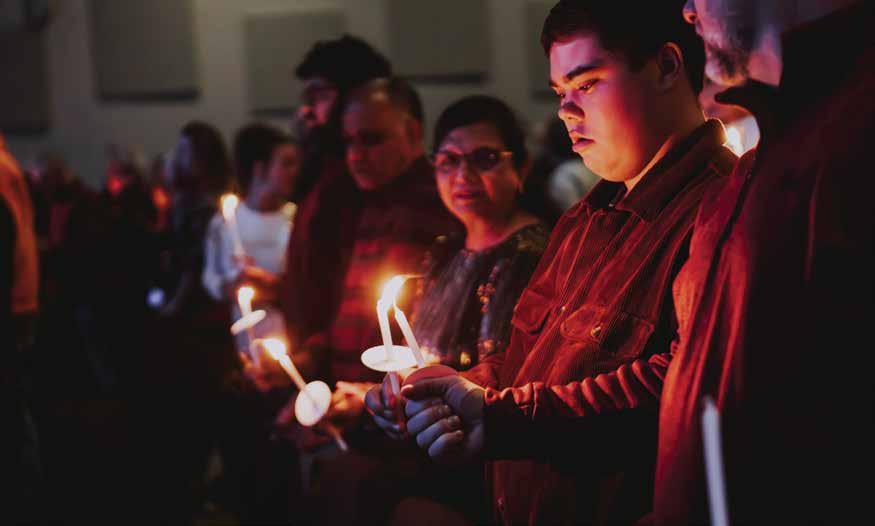
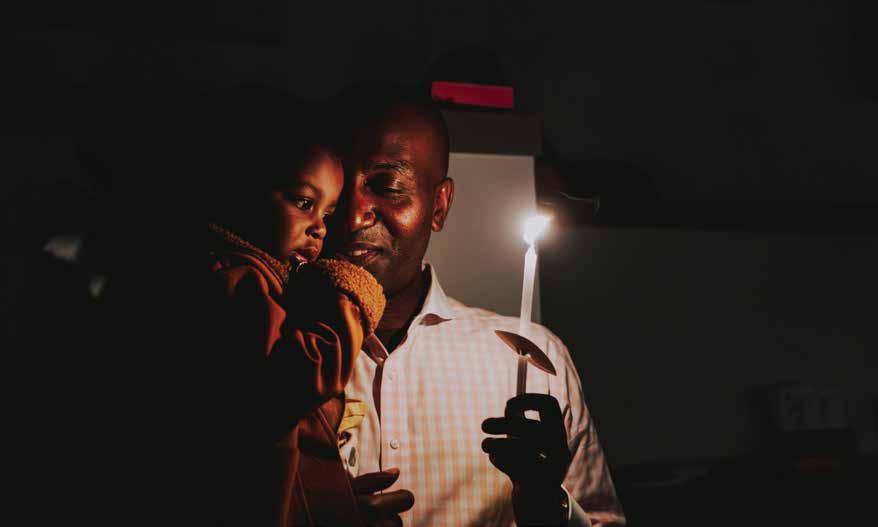

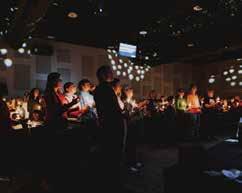

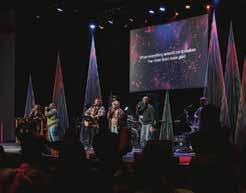
The Anderson Homes Foundation’s ‘My First Home’ initiative opens doors for fi rst-time homeowners.
BY KELSEY WINKELJOHN | PHOTOS BY LOVE COLUMBIA COMMUNICATIONS MANAGER CAROLINE ROUSH

At one point, the “American Dream” was epitomized by a speci c image: the nancially stable nuclear family living behind a white picket fence in a suburban home with a well-manicured lawn.
e United States has long promoted that dream as attainable through hard work, sacri ce, and risk-taking.
Today, we not only recognize that families come in diverse forms, but that homeownership is more of a privilege than a universal reality. Systemic barriers — such as limited access to education, discrimination, and, most palpably, the rising cost of housing — continue to stand in the way for many.
Columbia is just one of many cities grappling with a housing crisis. While community members have discussed the issue
and proposed various ideas at length, few concrete solutions have been successfully implemented to tackle the problem. at prompted the formation and mission of the Anderson Homes Foundation (AHF), which Russ Anderson and Mark Briley of Anderson Homes co-founded. With Anderson’s background in home building, Briley’s experience in ministry and community engagement, and their shared passion for helping under-resourced families, they were already halfway there.
“We were passionate about starting the Foundation, though we didn’t know what form it would take,” said Briley, who also serves as president.
Anderson and Briley were invited to an A ordable Housing Coalition Meeting in May 2023 at Love Columbia, where it was revealed that twenty-seven families had been certi ed and approved for rst-time homeownership. Still, only one home in
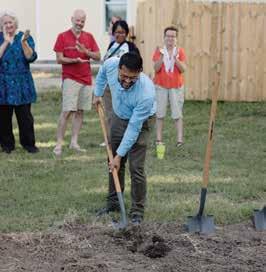
the area met the cost criteria for those families in Columbia’s market.
“ ey wanted homebuilders at that meeting so we could talk about what that looks like,” Briley added. “Russ and I shared our passion for helping low-income families achieve their dream of homeownership, and we got a call the next day from somebody who was at the meeting who said, ‘ ere’s all these ideas to address affordable housing, and it seems like nothing ever happens. But the stu you were talking about — is that something we could do?’”
From that conversation, the “My First Home” initiative was born.
AHF has partnered with Love Columbia, another local nonpro t, to bring the “My First Home” initiative to fruition. AHF’s contribution to the partnership involves leveraging Anderson Homes’ reputation

While the initiative’s primary goal is to help families nd and settle into a ordable housing, its broader aim is to foster long-term nancial stability.
FOUNDED: 2023
(granted nonprofit status)
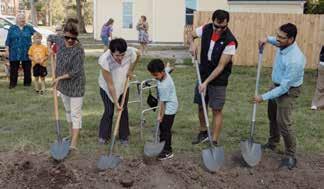
MISSION
We’re not just building homes, we’re building community.
SPONSORS
• Mike and Rockie Alden
• Eli and Lindsey Drinkwitz
• Brian and Cynthia Gardner
• Blair and Melissa Murphy
• Love Columbia
• David and Lori Atkins
PARTNERS
• ABC Supply
• AireSolutions
• Bell Bank
• FHC Ready Mix – East
• Johnston Paint and Decorating
• Kretch’s Custom Exteriors
• Mid-City Lumber
• SEB Fencing
• Straight Line Striping
and in uence to scout and secure property, donate human and nancial resources for building each home, and secure additional support from local vendors and construction partners to lower the overall sales price of each house. Love Columbia focuses on using its connections with the city of Columbia and Boone County to reduce barriers in the building process, coaching and certifying families to become candidates for the initiative, and promoting ongoing life coaching andnancial literacy for homeowners.
e two partners are also supported by sponsors — generous donors who either pay for the build in cash or through loans and are reimbursed in full when the home is built and purchased by AHF — and by the occasional surprise helping hand. For instance, a realtor recently volunteered their time to assist new families in getting settled and connected with essential homebuyer resources like utility companies.
Once sponsors sell the homes to AHF, families purchase the homes from the Foundation. From there, the only contract stipulations at the point of sale include AHF being the lien holder of the property for ve years. If the homeowner chooses or needs to sell before the end of the ve-year lien period, the Foundation has the option to purchase the home for the original purchase price.
After the lien period concludes, the homeowner becomes the sole owner of the property, fully responsible for the remainder of the loan, and the full beneciary of the home’s equity.
“Studies have shown that homeownership creates stability for folks generationally speaking,” Briley explained. “[With renting] there’s never any accumulation of resources for a family, so homeownership starts that track. It allows them to stay put longer in one spot, and when you’re in one spot longer, your job tends to be more steady and sustainable.”
e Foundation’s most signi cant challenge is securing enough affordable properties for development and ensuring su cient sponsorship to fund the houses. at is especially di cult given the ambitious goal of constructing twenty homes per year. Briley estimated that reaching that target would inject approximately $1.4 million in equity into low-income families’ households each year in Columbia.
To address the challenges, the Foundation is committed to broadening its outreach to raise awareness about sponsorship opportunities. Securing funding is crucial to increasing the number of homes built.
Additionally, the Foundation aims to create mixed-housing neighborhoods, recognizing that diverse communities foster greater strength and upward mobility.
“All sociological research indicates that the more you diversify a community, the stronger it becomes, promoting upward mobility,” Briley explained. e co-founders aspire to provide families with opportunities to connect and build a supportive community.
rough the “My First Home” initiative, the Foundation is not only helping families achieve homeownership but also laying the groundwork for a more inclusive and resilient Columbia. By bringing together families, sponsors, and community leaders, AHF is turning the vision of a ordable housing into a lasting reality. With continued community support, the initiative can grow and help achieve the a ordable housing goal of ensuring that no family is left behind.



BY M C KENNA STUMPH

An 11-year-old rock guitarist channels Joan Jett. An intergenerational rock band choir (aptly dubbed, IGRB). A “Little Rockstars Camp” for young girls that focuses on empowerment and creative expression.
ose are just a handful of myriad outcomes — and showcases — from Compass Inc. music students who prepare for live audiences with youth open mic nights and other inviting opportunities. Compass programs director Violet Vonder Haar further explains, “We have a band that is playing at the Biscuits, Beats, and Brews. e guitarist is 11 years old and she’s ri ng on rock songs like Cherry Bomb. Getting to see them evolve, grow, and become more condent in themselves and as musicians, there’s nothing like it.”

Founded in 2007, the nonpro t Compass Inc. o ers aspiring musicians, singers, and songwriters a place and programs to achieve those goals. e organization has experienced exponential growth since moving into and establishing the Compass Music Center at 1107 University Avenue in June 2022.
“ e students are getting the opportunity to perform in a safe space, where it’s low stress, where if they make a mistake and hit a wrong note, I can be like, ‘Hey, it’s okay, we’re just having fun,’” Vonder Haar explained. “ e kids that continually show up have shown a lot of promise and progress.”
One of the biggest stars in the nonprofit’s seventeen-year history is the Veterans United Foundation, which doled out $10 million in grants for the foundation’s ten-
year anniversary. at was in 2021, and Compass received a shade under $225,000.
“It was a godsend,” Vonder Haar added. “It paid, down to the dollar, for the renovation process. I think I paid six dollars out of pocket.”
Before she became more hands-on with the organization, Vonder Haar was an artist who participated in some of the early showcasing performances in 2009. In 2012, she was brought on as a sta member for the rst Compass music camp.
e camp is for youth ages eight to eighteen, and they are divided up into bands. roughout the day, they take di erent classes, such as music theory, music history, stage presence, and an art class is focused on making their own band logos and album designs. ere are


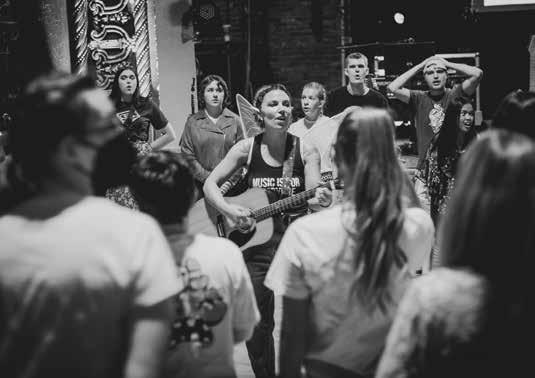

“The students are getting the opportunity to perform in a safe space, where it’s low stress, where if they make a mistake and hit a wrong note, I can be like, ‘Hey, it’s okay, we’re just having fun.’”
Compass programs director
also classes for recording, how to perform on stage, and how to run sound. e songs the students work on and write throughout the camp are recorded. At the end of the week, the music students and bands perform in a showcase.
Since opening its new location, the Compass programming has expanded beyond the camp experience. In addition to the summer camp, new camps have been added including: an introduction to music camp, Little Rockstars Camp for young girls, songwriting camp, and the intergenerational rock band choir (IGRB). e IGRB is a choir for all ages, singing rock and pop songs that span the decades, backed by a rock band and showcased at the Blue Note. Compass will also add a folk choir directed by Vonder Haar. In the spring, Compass will o er an acapella choir, youth open mics, and lesson programs.
e Compass team also strives to make programs and lessons more accessible. e “Music is for Everyone Fund” helps provide scholarships for low-income families.
“ e majority of our sta members, aside from just appreciating music, also have an understanding and appreciation for the healing power of music and the power to bring people together,” Vonder Haar noted. “It’s at the root of everything we do. e most important thing is that the students have a positive experience with music. e goal for them is not to become some virtuoso but to just have fun. It’s kind of a holistic approach.”

BY JODIE JACKSON JR | PHOTOS BY LANA EKLUND
Hand-crafted items made by City of Refuge clients, and donations of like-new or gently used clothing, footwear, and other items from the community, are available at City Boutique. e resale shop located at 10 N. Garth Ave. helps support the nonpro t’s services for refugees and immigrants relocating to Columbia and central Missouri.
And the handcrafted wares all have a refugee’s story attached to them. For instance, the beaded handbags are made by a woman from Afghanistan, and the $25 price is returned to an Afghani orphanage. en there are scrunchies, made by a 10-year-old Malaysian girl who started (and, apparently, still hasn’t stopped) making the adorable little hair accessories after attending a City of Refuge sewing class with her mother.
A bundle of four scrunchies is $4. e shop is open from 9 a.m. to 4 p.m. Monday through Friday.
Also put this on your calendar: e second City of Refuge Holiday Market, set for 9 a.m. to 3 p.m. Saturday, December 7, at City of Refuge. e market will showcase local (and refugee) artisan work. ere will be food, hot beverages, entertainment — and even a visit from Santa.
City Boutique accepts donations from nonsmoking homes. Items may include kitchen and bathroom housewares, home decor, seasonal shoes and clothing in good condition with no rips or tears (newborn through adult), electronics, toys, sheet sets, comforters, blankets, rugs, and towels. Basically, any item to set up a new home.
All smaller donations can be dropped off at 10 N. Garth Ave., between 9 a.m. and 1 p.m. Monday through Thursday. (Please do not leave donations outside the door after hours.) Larger items such as furniture need to be submitted online for approval.
$5

$6

$25
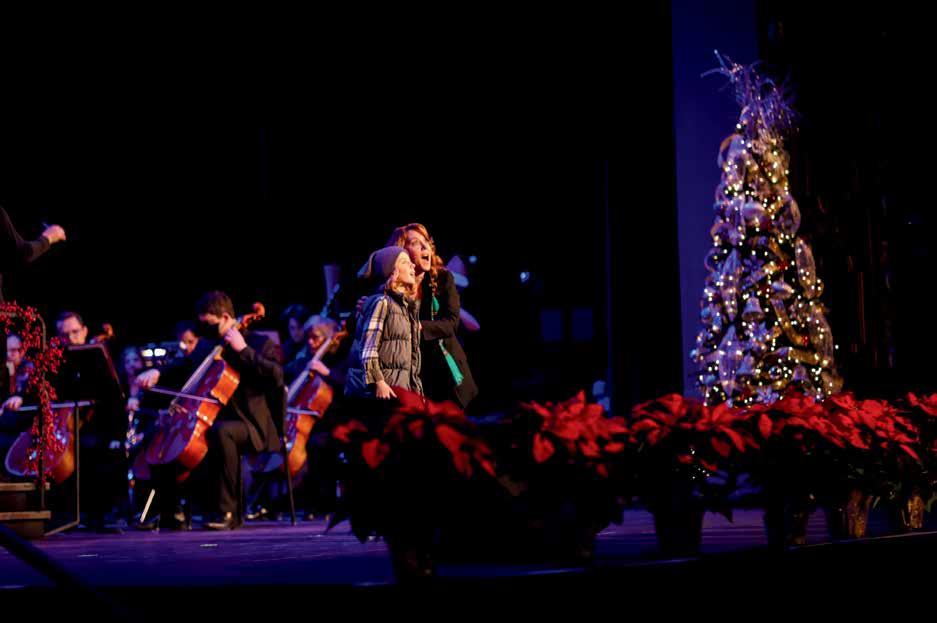



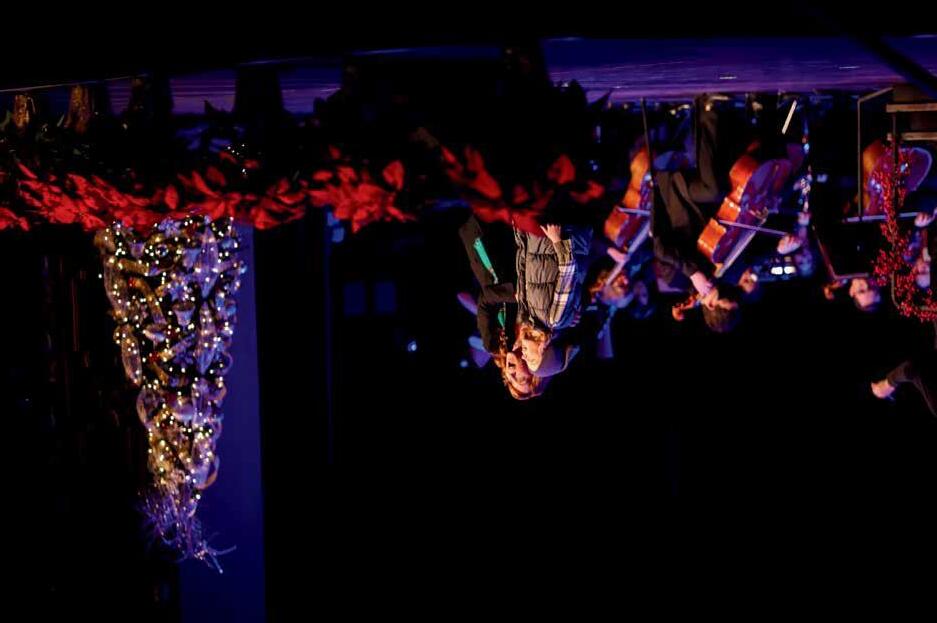






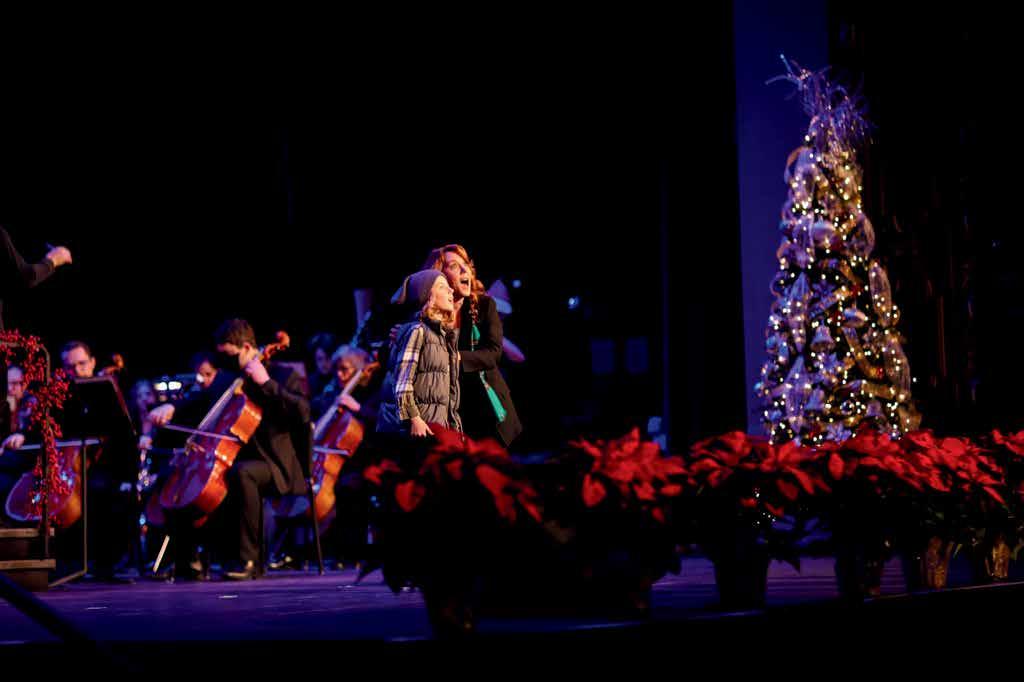
Your vote matters, and so does your mental health.
Election season can be overwhelming. With constant news updates, debates, and political tension, it’s easy to feel stressed and anxious. At Burrell Behavioral Health, we care about your well-being. Our article, How to Care for YOU this Election Season , offers practical tips and resources to help you stay grounded and manage your stress.
Holding conversations aimed at bridging differences can feel daunting, but with empathy, curiosity, and compassion, we can create stronger connections and better understand each other. Whether you’re feeling frustrated or just drained from it all, we have a guide to support you.
Find relief today. To view the guide and learn more, scan the QR code or visit burrellcenter.com/election-stress




Missouri receives more than 70,000 reports of suspected child abuse or neglect each year.
Missouri Girls Town provides a safe, loving, and stable family atmosphere for the girls residing on our campus – something many of our residents have never experienced before.
By supporting Missouri Girls Town, you
•Provide services to more at-risk youth
•O er sta development opportunities
•Assist our employment of licensed clinicians
•Maintain the 10 buildings on our 23-acre campus
•Deliver aftercare services
Gifts of $100 or greater qualify for 50% Missouri state tax credits available through the Department of Economic Development's Youth Opportunities Program.
You can make a di erence in the lives of young girls. Donate online at MissouriGirlsTown.org or contact Director of Donor Relations Deanna Barger at dbarger@mogirlstown.org or 573-642-5345.



After a year and half of traveling from St. Louis once per week to our clinic, Dr. Amy is finally a part of our team full-time! Dr. Amy Whitlock is a dedicated Doctor of Chiropractic with a lifelong passion for holistic health. Dr. Amy graduated from Logan University in 2018, after completing her undergraduate studies at MacMurray College in Jacksonville, IL. Outside of the office, Dr. Amy is a proud wife and a mother and enjoys spending time with her family exploring the outdoors, hiking, and traveling. Dr. Amy is deeply committed to supporting families on their health journeys, especially during pregnancy and childhood. She believe there’s nothing more rewarding than witnessing families thrive through all of life’s milestones.


“I’ve had the great privilege of seeing patients thrive under Dr. Amy’s care in our practice for over a year now. She is a fantastic addition to our team and we are delighted to finally be able to welcome her as a full time doctor at Tiger Chiropractic.”
— Dr. Amanda Owens, Owner of Tiger Family Chiropractic
MO Feel like yourself again.
Recognizing the people, places, and events serving as change agents in Columbia.
BY M C KENNA STUMPH | PHOTOS BY ANTHONY JINSON
Columbia is built on the generous contributions of nonprofit organizations, volunteer work, philanthropic events, and numerous endeavors that bring the community to life. These community-impacting efforts are led by passionate individuals looking to make a difference without seeking anything in return.
It is our honor at COMO Magazine to shine a light on those who have made lasting impressions on our community.
Please join us in celebrating the accomplishments of our 2024 Impact COMO award recipients and honorable mentions.


Mitzi Clayton rst became involved with Heart of Missouri United Way (HMUW) when then-MU Athletic Director Mike Alden asked her to serve on the campus United Way campaign committee. Later, she became more involved with the nonpro t in 2009 when she served as Mizzou’s HMUW campaign chair.
“What initially seemed like one more thing on my to-do list — and a rather daunting one at that—would grow into such a personal passion. It serves as a reminder of how God is always at work in and through us, if we’re willing to just say ‘Yes,’” Clayton noted.
Clayton has held the positions of community campaign chair, president, vice president, and Community Impact Committee chair throughout her time with United Way. Along with the rest of the board, she provides oversight, trustworthiness, and credibility for the community members, ensuring their con dence in how contributions are being invested to meet big needs in Columbia.
She has a deep appreciation for HMUW’s allocation process and how funding requests are reviewed and considered.
“It truly is special and should give HMUW supporters great con dence that their donations are being strategically allocated to create the greatest impact,” Clayton added.
Clayton also joined the Board of Directors for Women’s Intersport Network (WIN) for Columbia in 2018 and has served as the board president for the last two years. e primary focus for the organization has been hosting an awards luncheon to celebrate and recognize the achievements of girls and women in sports and physical tness.
Recently, WIN for Columbia worked to expand by reimagining its mission and making a greater impact on women and girls in the community.
at was done by organizing a National Girls and Women in Sport Day celebration each February, hosting a WIN Every Day Girls in Sport Leadership Seminar free for all high school females to attend each July, and establishing a Together We Win fund for girls with demonstrated nancial need in eighth grade and below to participate in sport activities.
Clayton credits her drive for giving back to the community to her parents.
“My parents both gave of their time, talents, and treasures to various organizations ranging from making braille bibles for the blind to delivering Meals on Wheels,” she explained. “ ey set the standard for which I strive to achieve. I was raised to believe ‘if you can, do.’”

In uenced by her family, Lauren Karr has been giving back to the community through serving with Job Point for six years and was board chair from 2023 to 2024.
“A value [my family] taught me early in life was, ‘What can be lacking in monetary value, can be more than made up for in quality time,’” Karr explained, o ering some examples of that quality time: “Saturday morning homemade breakfasts after a sleepover, or co ee with the guys for good grades — mainly me eating a cinnamon roll and listening to them talk, but I felt super cool. ey not only told me but showed me what it means to serve and give back.”
When her son became ill and was hospitalized in 2018, she was grateful for the work of Certi ed Nursing Assistants (CNAs), especially during COVID when the hospital stays were limited to one visitor or parent per patient.
“[ e CNAs] were there day and night and worked tirelessly to keep a then 2-year-old happy during 4 a.m. stat checks, so it was a thrilling surprise to nd out Job Point o ers a course for CNAs,” Karr said.

With his experience as a youth coach for twenty years, Rick Matheny began to serve with the Day Dreams Foundation four years ago. He is now board president and treasurer. e nonpro t is helping children get involved in sports by paying for registration fees and proper equipment for their participation.
“From my own experience, as a child of a single mother, who found ways to get us involved in activities despite a tight budget, I realize how much those activities mold and a ect lives in profound ways,” he explained. “It’s heartbreaking to know that some children do not have that opportunity. Enriching children’s lives during their youth — and knowing the opportunities that their acquired skills will provide in their adulthood — is very rewarding.”
In 2023, Day Dreams Foundation tripled its revenues and the number of kids served from the two previous years. “I’m proud of the board for managing the growth we experienced and helping to guide and enhance it,” Matheny said.
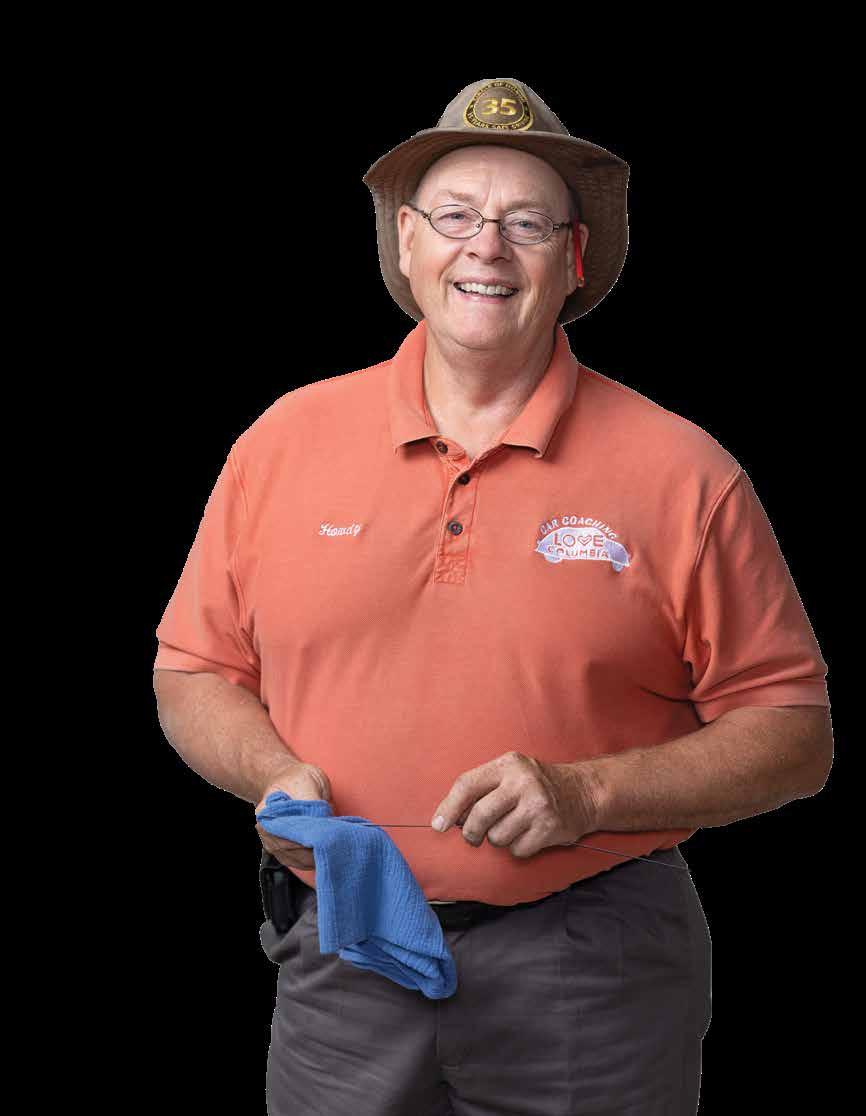

Keith “Howdy” Matheny has been a part of Forum Christian Church for forty years, serving as an elder and member of the board. He was given the nickname Howdy when, as a UPS driver, he greeted each stop with a hearty “Howdy.” George Liggett, owner of e Nostalgia Shop, had a parrot that would repeat “Howdy, Howdy,” over and over.
At Forum, he has led the benevolence committee and has been involved as a middle school Bible class teacher, small group leader, and bus driver, and now helps train others to get their commercial driver’s license (CDL) as well.
Serving with the church and God is what led him to Love Columbia.
“ ere is no doubt in my mind that God has, for the last forty years serving with Forum’s benevolence, prepared me for serving with Love Columbia,” Matheny said, adding that he knew about the organization — formerly called Love INC — for some fteen years. In fact, Forum member Carol Paten encouraged Matheny to meet her close friend, Jane Williams, a founder of Love INC and the executive director of Love Columbia.
“I am one person, but I have a great village that helps me,” Matheny said. He was trained by Dr. James Ferneau to handle the benevolent needs of the church. Bradley Williams, Forum’s senior minister, encouraged him to pursue the role with Love Columbia as an extension of Forum’s contribution to the community.
Matt Copeland with Christian Chapel Church contacted him about creating a city-wide repair ministry with partnering churches and connecting him with Williams and Love Columbia. rough that partnership, Tiger Towing provides a discount and the Veterans United Foundation contributes via a “get to work” grant.
Matheny’s extensive experience with cars in uenced his purpose for Love Columbia. For three years, he has diagnosed donated vehicles and client’s vehicles, which gives the nonpro t an approximate cost to budget for the repair. He also educates people about car care and maintenance by teaching a car maintenance class, which he not only teaches at Love Columbia, but also as an extension to groups like In2Action, MyLife Clinic, Central Bank’s PosperU, and more.
Rod Petersen, Forum’s community outreach minister, said, “It was God’s plan that Howdy and Jane Williams’ paths someday would cross, and what a beautiful bene t to our community that was created.”
“I am one person, but I have a great village that helps me.”
HONORABLE MENTION

Association
Michael DeShazo is the founder and chairman of the board for Mid-America Special Sportsmen’s Association, which has been around for twenty- ve years. e nonpro t provides hunting adventures for individuals with disabilities. DeShazo hopes to never be positioned to tell an applicant “No” for a hunt, which he has not had to do in the organization’s history.
“ e misconception would be that we just harvest animals, but in reality, we provide a means of giving con dence and let individuals feel like a regular person just for a little while,” DeShazo said.
He credits his wife, Lori, rst for getting him and the organization to the place it is today. He also mentioned the hundreds of individuals that have volunteered their time and e ort to make the adventures possible. e rst donors to Mid-America Special Sportsmen’s Association were Lee’s Tires and Bass Pro, followed by MidwayUSA. However, DeShazo said it is the many individual donors who have made the biggest di erence.
DeShazo is most proud of being in a position to change people’s lives and hopes to keep providing hunting excursions to everyone who applies. In his o time, he enjoys woodworking and secretly restoring furniture for unknowing recipients, claiming it is “very rewarding.”
DeShazo says his favorite community activity is being active in his own organization and helping, when possible, other organizations focusing on raising people up.
“ e way I was raised, my religious beliefs, and how I would want to be treated” are the things that motivate him, DeShazo says.


Darin Preis has led Central Missouri Community Action (CMCA) for nineteen years.
“I guess at the end of the day I want to be able to tell my son that I did the best I could to make a di erence in our community,” Preis said, citing one thought that motivates him.
As executive director, Preis is responsible for CMCA’s public image, funder relationships, board management, agency budget, sta morale, the work equipment, internal and external communication, and “turning out the lights at the end of the night.”
“As the executive director, I take all the blame for the bad stu and spread the love when good things happen,” he added. “I try to establish a vision for our organization and set an example that our 220 employees can follow. I am at the top of the organizational chart and try to keep us all rowing in the right direction.”
Preis’ goals for CMCA are to build relationships to empower people, strengthen resilience, and improve quality of life for all members of the community. e organization’s strategic priorities include employment and income support, health, housing, and becoming an Agency of Excellence (a Baldrige-inspired certi cation from CMCA’s National Community Action Partnership).
Several projects are in motion, such as building forty workforce apartment units in Je erson City and fourteen a ordable homes for sale in Columbia this year. He is working on plans to build another forty apartments in Mexico and up to thirty homes in Fulton. Preis also plans to support the Head Start director and team to meet the new challenge of meeting approximately 1,200 standards — a part of the new Head Start Program Performance Standards, which were updated for the rst time since 2016. Head Start is a comprehensive early childhood education experience that provides both quality classroom experiences and a whole family approach that holistically supports the entire family. It is CMCA’s largest program.
“My personal goal is to maintain my own work/life balance so that I can be everything CMCA needs me to be,” Preis explained. “I want to be at my best so that I can be present for my team and make sure CMCA is living up to its mission. is means keeping my wife, son, and dogs top of mind as I plan each week. e cat is on her own.”
HONORABLE MENTIONS

Trent Rash has led the Missouri Symphony, or MOSY, board and organization for ve years. Before becoming an arts administrator, he was a college voice professor, and he still teaches adjunct voice and private voice lessons on the side.
“I highly value kindness, music, and connection. ese three things guide how I move through the world, and I am constantly attempting to give all three to those with whom I come in contact,” he said. “ e people who need access to basic human needs — which I strongly believe includes music! — motivates me to be a better person and build a better world.”
Rash has many roles as executive director including, chief executive o cer, the chief people o cer, the chief fundraiser, and handles all public relations. He is proud to have overseen the search and hiring of MOSY’s third-ever music director in its fty-four years of existence.
“Wilbur Lin has been a welcome addition to the Columbia classical music scene and is challenging our audiences with thought-provoking programming,” Rash added.
Rash credits his small-town upbringing for getting him where he is today. He learned the value of hard work and aspiring to large goals, even if it does not seem possible. He mentions his hardworking peers in the nonpro t sector for his excitement in volunteerism.

Executive Director Debbie Beal has had a signi cant impact in a short amount of time, from helping guide the now-annual Holiday Market to a wide array of services for refugees who now call Columbia home.
“Our endeavors — like our markets, our thrift store (City Boutique), our food trailer (City Cuisine), our preschool — are always multifaceted and multipurposed. In addition to providing employment or income earning opportunities, we are also striving to raise awareness and educate our broader community about what a refugee is and is not and how we can work together to welcome our newest neighbors. We cannot do it alone,” Beal said.

Gregory N. Bell Woodhaven

Gregory N. Bell has been with Woodhaven for forty-two years and is now the chief operations o cer. He has been a part of the expansion of services for the nonpro t which resulted in the organization’s growth from $12 million to $22 million in ve years. His role as the COO involves oversight of the day-to-day administrative and operational functions of Woodhaven’s programs and services. e role involves operational, strategic, and performance management along with leadership tasks.
“A common misconception is the COO is merely a backup to the CEO,” Bell explained. “In many cases, the COO is focused on the internal operations and strategies of an organization and plays a vital role in the day to day operations.”
As for Bell’s goals, he plans to expand programs throughout all of the services that Woodhaven provides, assist with the Workforce Development Center and with the development of the Community Connections program, increase participants in the residential program, and professional development for Woodhaven’s leaders to create a positive work culture.
“I give all credit to Woodhaven’s dedicated workforce who are committed to ful lling our mission and embracing the abilities of all of the individuals we support,” he said. “We wouldn’t be where we are without our amazing sta .”
In the upcoming years, he would like to obtain Woodhaven’s tenth consecutive Commission on Accreditation of Rehabilitation Facilities (CARF) Accreditation, increase participants in all service programs, further enhance the competency of all employees to continue to provide high quality support, reduce turnover and overtime expenses, increase sta salaries, and implement the nonpro t’s new strategic planning goals.
He also credits the Board of Directors for the help that it provides through its commitment to Woodhaven’s mission and the individuals Woodhaven supports.
Bell said he enjoys spending time with the youth who are participants in the programs, helping them overcome obstacles as they become respected members of the community. He is proud to be providing internal career growth opportunities for employees and watching them individuals grow both personally and professionally. at goal extends to the individuals Woodhaven serves.
“We work hard every day to nd community employment opportunities for our individuals,” he stressed. “We educate our community that our individuals can be productive employees.”
HONORABLE MENTIONS

Conrad Hake is the program director for Love Columbia and has worked with the nonpro t for four and a half years. In 2021, he began the process of obtaining approval from the U.S. Department of Housing and Urban Development (HUD) as Columbia’s rst Housing Counseling Agency, and that was achieved in January 2023.
“ is pursuit was borne from a vision to help lowincome families build wealth by achieving dreams of homeownership,” Hake said. “We saw homeownership as a necessary, missing step to breaking the cycle of poverty, especially among minoritized households.”
He explained that one of Love Columbia’s core beliefs is that the root of poverty is broken relationships.
“We’ve seen a lot of collaboration in the past few years, especially coming out of the pandemic, and it’s due to organizations coming together through the many coalitions and workgroups that ensure we can go farther as a community together than any organization could alone,” he added.

Mike Davis began his career in the military in 1993, and that in uenced his role with Truman Memorial Veterans Hospital and Fisher House Foundation, where he has been a housekeeper since 2019.
“I served my country during the Operation Freedom campaign after high school from 1993 to 1995. I think this was the time in my life that I made a commitment to live a life of service,” Davis said.
“As a housekeeper it gives me the exibility in my workday to sit down with patients who could use some optimism in their life,” he added.
Davis created a space for families to invest in their community with community gardens. He built the gardens within the district holding the families of his students accountable for their maintenance.
“I like to learn about people, I understand generations of Americans, and I feel comfortable discussing life with people. I’ve been told that I have good ears and listen well. I don’t know about that, but I know I make a di erence in peoples’ live’s daily, and the families and veterans make a di erence in mine as well.”
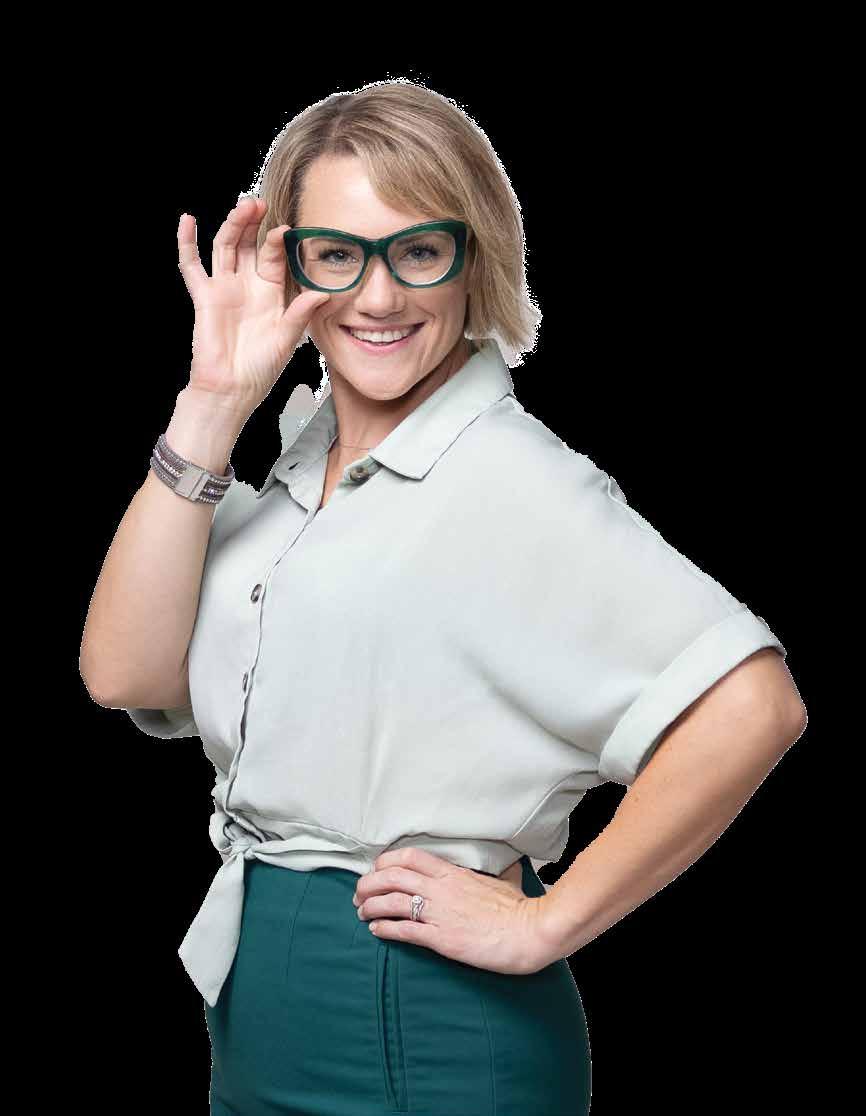

Ashley Switzer has been with Show-Me Central Habitat for Humanity for fteen years, ve of them in Columbia, and is now the director of community outreach. She is most proud of Women Build.
“Well over 100 women from our community not only volunteered to build for a weekend — they came in the June heat,” she remarked. “ is event was meant to build homes, build bonds, and give these women some time to get pampered at brunch after giving so much of themselves to their community.”
“A participating homeowner said, ‘I was so nervous to come out with so many women and I honestly didn’t think I would t in. After the rst day, everyone felt like best friends! I can’t believe how many people would do this for my family,’” Switzer recalled. “Women who didn’t know each other now play pickleball once per week. Several come to Habitat and volunteer regularly. Relationships are what we are most proud of.”
Habitat is a housing nonpro t that partners with low-income families to achieve their goal of homeownership. e volunteers and participants at Habitat for Humanity share a dream in which everyone has a decent and a ordable place to live.
“Many people think Habitat picks a family, they get this free house, and are then set for life.
ese families pay an interest-free mortgage for the amount it costs to build their home with volunteer labor,” Switzer explained. “ e volunteers make the home a ordable, but these families work alongside volunteers to build, do education to set themselves up for successful homeownership, and pay a mortgage just like everyone else.”
e mortgage payments go back into the program to help fund the next build. Many of the families that join the Habitat program are on some form of housing assistance, such as HUD’s Section 8, that can then be redistributed to community members on waitlists, she said.
Habitat for Humanity plans to make Women Build an annual event. is past year, Habitat hosted Women Build in the new, fty-acre Boone Prairie Subdivision, which will become home to 143 Habitat families.
“Investment in a ordable housing is a huge issue and focus for Boone County and we are proud to be part of that e ort,” Switzer said.

Kate Stull has worked with Access Arts as president of the board of directors. She is working to evaluate the best ways Access Arts can provide creative learning experiences for anyone in the community, including providing sound leadership and balancing the budget.
“I am an artist with a history with Access Arts — as many do in Columbia,” she said. “I’ve participated in the ‘Empty Bowls’ fundraiser involving Access Arts and the Columbia Center for Urban Agriculture by creating ceramic bowls with my daughter. My daughter also spent a lot of time at their exciting summer camps and always brought something interesting home to admire.”
Stull mentions CelebrARTy, an Access Arts signature annual fundraiser since 2014, as one of her accomplishments since serving with the organization. It was revived and reconstructed after COVID, which led to the event’s increased net pro t of 185 percent. It has become the most pro table fundraiser in the organization’s 50-plus-year history.

e 2023 City of Refuge Holiday Market certainly made a mark as an impactful fundraiser.
“We weren’t sure what to expect when putting on a rst-time outdoor event in the middle of December, but we were blown away by the sheer amount of people who came from all over Columbia,” said City of Refuge CEO Debbie Beal. “Many folks had never heard of our nonpro t, or if they did, didn’t know what we did in-depth.”
e event allowed City of Refuge to raise awareness about its daily work and generated interested from potential volunteers. e Holiday Market also provided a supportive structure for the debut of new artisans in Columbia.


Erica Bressman is the administrator of Flat Branch Home Loans - e Giving Branch and has been with the nonpro t since its beginning in 2019. As the only paid employee of e Giving Branch, she has many roles such as facilitating monthly meetings with the region committees, constructing and executing all programs including e Giving Branch scholarship for working adults, Homeownership Month, Breast Cancer Awareness Month, and more.
Last year, e Giving Branch had a goal of holding its rst Giving Branch fundraisers. Four fundraisers throughout the region raised more than $40,000.
Before connecting with e Giving Branch, Bressman did not have any experience in the nonpro t realm.
“Pulling this o was incredible and we were all so proud of the accomplishment,” she said. Upcoming goals for the nonpro t include increasing employee participation.
“We are doing great things with these funds but could be making an even larger impact with more participation,” Bressman remarked.
e Giving Branch also hopes to successfully launch its Community Outreach program and keep it as an opportunity for the employees for years to come. Every year, at its all-employee rally, the group discusses and votes on goals for the coming years. Bressman’s reason for giving back to the community is the overwhelming feeling of happiness she experiences when doing something for someone in need.
“For example, when we built a fence for a little boy with Butter y syndrome, or when we were able to support a grandmother in our community who had taken on all of her grandchildren - one with extreme medical needs - with a new minivan, those feelings of taking a little bit of the weight o of their shoulders is something that will continue to motivate us to continue serving and giving back,” she explained.
Each person who contributes 1 percent of their pay to e Giving Branch earns a pair of green Converse tennis shoes, a symbol of their dedication to the community. If you see those green chucks walking around, it means that person has dedicated not only their hard earned income but their time to further support those in need.
Bressman cited some of e Giving Branch’s values, including “having compassion, empathy, and humility for those in their greatest time of need. Also having transparency with our employees who so graciously give their funds, continuing to share with them the work that we are doing in our communities.”
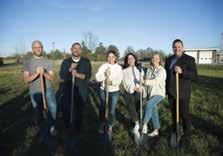
Russ Anderson, co-founder and CEO, and Mark Briley, cofounder, president, and director of client and community relations for Anderson Homes, made Anderson Homes
Foundation an o cial 501c3 nonpro t in 2023. In a meeting hosted by Love Columbia in May 2023, the A ordable Housing Coalition revealed that only a single home existed in Columbia’s market that t the cost criteria for twenty-seven families that were certi ed and approved for rst time home ownership.
“As home builders, we were uniquely positioned to do something special to give hard working neighbors in Columbia the chance to be rst time homeowners and left that meeting with the vision for our Foundation’s rst project: e ‘My First Home’ initiative,” Briley said.
“Not only would we build in incredible equity from day one, we would also build a top-rated, e cient home ... reducing monthly utility bills by hundreds of dollars,” he added. “We launched immediately, building four homes for low-income families which began and were completed in six months’ time.”

Columbia Orthopedic Group (COG) has both sta and physicians who are on the boards for several nonpro ts, while also providing philanthropic support to multiple organizations within the community.
“One of our core tenets is ‘Moving You Forward,’” said Andrew Lovewell, COG chief executive o cer. “We use this as a framework for our support to nonpro ts and other local organizations. We support organizations that help facilitate moving people forward in some capacity.”
Some of the organization’s higher pro le accomplishments: funding an expansion of the Food Bank, providing signi cant funding to Welcome Home, and building a new co ee shop for Love Co ee at Columbia Orthopedic Group’s facility o Keene Street.




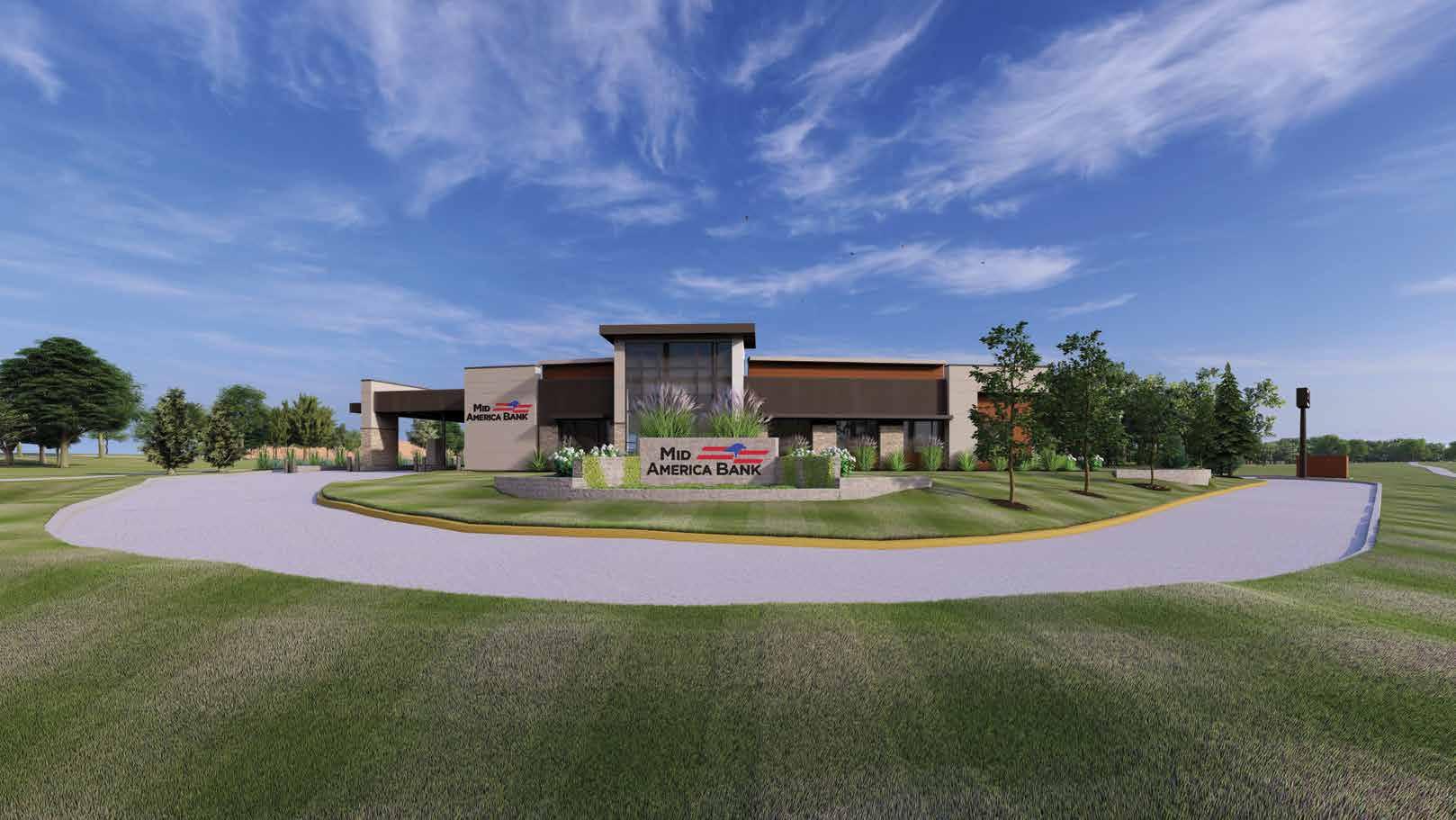



Show-Me
Central Habitat’s Women Build event is a real (em)power trip.
BY MICHELLE TERHUNE
Drive by most construction sites and you’re going to see a lot of dudes. e trade is full of them. But had you driven near Brown Station Road in north Columbia in late June, you might have seen a bunch of women wearing hard hats, toolbelts, and work boots, while wielding paintbrushes and power tools with equal con dence.
You would have witnessed Show-Me Central Habitat for Humanity’s rst major Women Build event.
About 150 women participated in the three-day build and brunch, June 21-23, including 115 who signed up and registered as volunteer women builders. ey worked on ve homes in the new Habitat subdivision during that stretch, all being built for women homeowners and their families.
Ashley Switzer, Show-Me Central’s director of community outreach and coordinator of Women Build, said the inaugural event stemmed from the overwhelming success of the chapter’s national ten-day Blitz Build held in September 2023.
Although Women Build had its beginnings nationally in 1991, and a smaller e ort in 2018 was held in Columbia, 2024 was the rst year for a large-scale event. And based on its success, it won’t be the last. e army of women in pink tee-shirts with hard hats emblazoned with the words, “Safety First. Sass Second,” it seemed, love to climb on roofs, lay ooring, install baseboards, hang doors, and paint.
Women Build couldn’t be pulled o without months of planning. Switzer met with the National Association of Women in Construction Central Missouri Chapter 341 about six months before Women Build. NAWIC’s members comprise women in infrastructure, residential, commercial, and industrial construction.
“ ey were really excited to provide some leadership for the event,” Switzer said. “ rough that group, we got connected with Rinehardt Construction and other local businesses that have women on their construction sta s.”
Show-Me Habitat also has a partnership with Stephens College’s Women in Trades program, a workforce development e ort to learn and apprentice in building construction, carpentry, and highway construction. Some of the program’s students tackled leadership roles as event volunteers.
“It was a really cool, full-circle moment,” Switzer added. “You learn how to build on the construction site, and you lead volunteers on the construction site.”
e logistics for such an event aren’t easy, especially when you want to work on ve houses, all in di erent stages of construction, at the same time. Show-Me Habitat must gather su cient materials and tools, not to mention food and beverages to feed the troops. More than thirty- ve Columbia businesses — many women-owned — sponsored the event through donations. Companies ranged from major sponsor EquipmentShare to local crafters who donated homemade kitchen towels, purses, jewelry, and more as items for purchase to raise more money.
While that may sound like any other Habitat event, it wasn’t. Each woman builder was challenged to raise $500 to help fund materials. Austin View, Show-Me Habitat’s executive director, said $37,000 in cash was raised, along with nearly $10,000 in donated building materials. And while a sense of camaraderie is inherent in any Habitat event, a female-focused event is an opportunity for more than manual labor.
“Cindy, who led our framing crew, showed us how to load a nail gun in a particular way where you hold it with your thighs. She said, ‘No guy will ever show you this, but this is the easiest way for me to do it.’ And everyone could do it after that. It was so heavy and awkward and bulky, but she knew how to show us so we could do it.”
– ASHLEY SWITZER
Show-Me Central’s
Director
of Community Outreach and
Coordinator
of Women Build
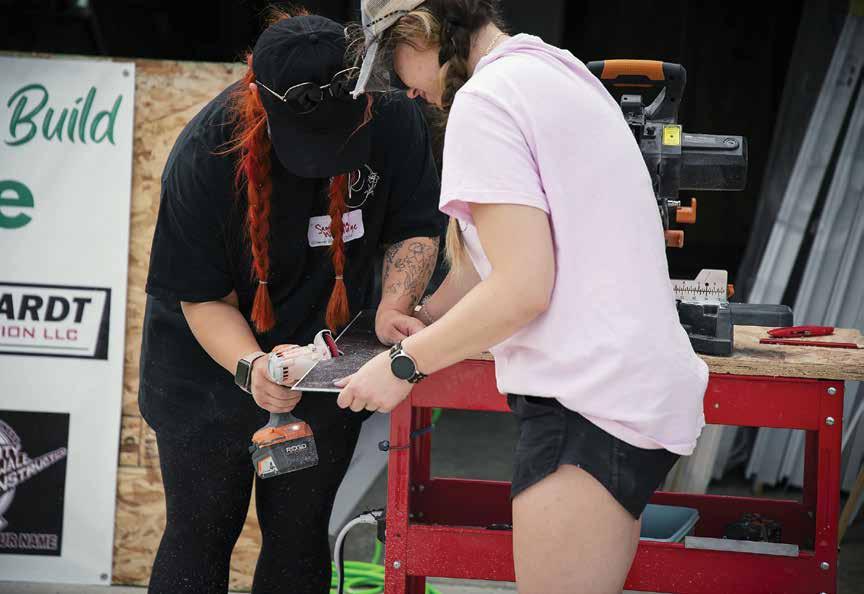
Mornings on the Women Build job site began with a Powerblast session led by Columbia’s Maya Angela McMillan. Part dance, part introspection, part self-afrmation, the warm-up was an energizing and emotional way to begin the day. at’s what rst-time volunteer and power-tool newbie Nikki Reese said.
“From the rst day of the build, the vibe was so electric. We started o with Powerblast in the morning. I will tell you, I actually cried,” Reese said. “It was so emotional thinking about what we were doing. We were told during Powerblast to ‘tell ourselves how proud we were of who we were and how far we had come.’ I don't think I have done that in a very long time. It was powerful stu . en throughout the day we were hearing Ashley cheering us on with her megaphone. We were shouting congratulations on each of our accomplishments. We gained new friends. It was so much fun.”
You’re unlikely to witness dancing at most construction sites. It’s even rarer to see a tent full of male construction workers enjoying cocktails and brunch, facials, and chair massages, making candles and oral arrangements, and playing yard games. But for Women Build, it was the perfect way to pamper everyone who volunteered while wrapping up the weekend.
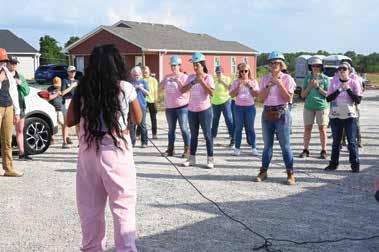
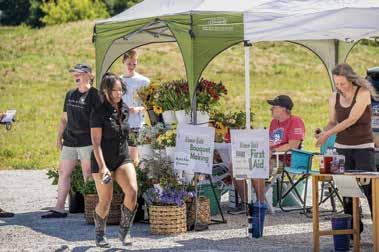



For so many of the rank and le, the experience instilled newfound con dence in what they can contribute to the community. Some women came already equipped with some impressive building skills. For those who did not, having an all-woman crew made them less nervous about learning new skills, like using power tools. e already skilled and the construction pros loved to share them with others.
“Cindy, who led our framing crew, showed us how to load a nail gun in a particular way where you hold it with your thighs,” Switzer says. “She said, ‘No guy will ever show you this, but this is the easiest way for me to do it.’ And everyone could do it after that. It was so heavy and awkward and bulky, but she knew how to show us so we could do it.”
Reese continued, “I got to overcome fears and use power tools I never thought I would. I believe in serving my community whenever I feel my heart is called to do so. is was a perfect match for me.”
Switzer con rmed that perspective.
“ is is a great way to engage women who might be nervous to come on a construction site and see what it’s like,” Switzer said. “ is is also a great way for our girlie friends to bond together by doing something di erent. You don’t always have to go shopping or for lunch. is gets you out in the fresh air and having a good time with everybody.”
Krystal and Brent’s house was one of the homes worked on during Women Build. Krystal, who was at rst shy about the skills she might need to put in her own sweat equity, found a community she’d been searching for among those she worked beside.
“ ese women took time out of their day to help me and my family’s dream come true,” Krystal says. “I got to learn how to use tools and skills I need for the future as a homeowner. I have a bunch of their numbers in my phone and a whole community to back me up.” is year’s success will make Women Build an annual event. But to beat the heat in 2025, it will be held in May instead of June. It doesn’t seem that extreme heat, cold, or rain will dampen the enthusiasm of those involved in Women Build, which Switzer describes as: “Women in construction working with women volunteers building women’s homes.”
She added, “When it’s just a bunch of girls empowering each other every step of the way, it’s a great experience for our women homeowners.”








































































City/county health department does more than give shots.
BY KRISTEN WALKER
It’s early on Wednesday morning, and “Anna” opens the front door at the Columbia/Boone County Department of Public Health and Human Services at 1005 W. Worley St. She has an appointment to get her boys vaccinated for the new school year. Not surprisingly, the boys are more than a bit reluctant. But the registered nurse on sta is patient. Anna needs to get the boys to daycare — and herself to work — before 9 a.m.
A year without insurance has put a thorn in managing her family’s health. With a baby on the way, utility bills increasing, and the family dog ready to be neutered, this is one more thing on her plate. Anna explains those fears, and the nurse sits back and quietly asks, “Would you like us to help you with those things?”
“Help me how?” Anna responds. e nurse smiles: “Let me get you a little more information.”
Managing your and your family’s health can be complicated, a task made more di cult without knowing the resources available in the community. However, the local city/county health department has a long history of being that helping hand.
“ e reason we are here is to serve and improve the health and well-being of the citizens of Columbia and Boone County,” says Community Health Manager, Trina Teacutter. “We want individuals that need assistance to feel comfortable coming to us so we can work with them to help them meet their needs.”
ough “Anna” is not a real person, the scenario accurately depicts a common interaction with local health department sta and services.
Local comic dishes on COMO’s standup scene.
BY RYAN SHEEHAN
Imagine yourself on a stage.

You’re standing up there by yourself with a microphone in your hand. You’re tired from working all day, and now you’re in a dimly lit bar late on Tuesday night, bright lights shining in your face, you’re starting to sweat, and you’re standing in front of a crowd full of strangers. Who are all those people watching you?
Does this sound like fun?
No, in fact, this sounds like a terrible idea, which is what you’re thinking as you’re standing up there on stage, microphone in hand, about to perform.
Why are you even up here anyway?
Well, it’s because you watched a stand-up comedy before, and you thought it would be easy. You watched some comedy specials or other comics perform live, and you thought you could give it a try. Everyone tells you that you’re a funny person, so why not get up on stage? Being funny in a conversation is the same thing, right?
No, it’s not.
But it’s too late now. You’re standing up there on stage, the host has already introduced you by name, people have clapped for you, and everyone is waiting in anticipation. You’re the one who signed up to do this thing, remember? No one forced you.
You have to perform.
And so, you do. You start your set by opening with one of your best jokes, your second-best joke ideally. And you save your very best joke for last. It’s the beginning and the end where your audience will remember your material the most.
But you’ve never performed your material before, only in your living room or in your car. So, you truly have no idea if the audience will think it’s funny. e only way to nd out is to do it live. Which is what you are doing, right now.
You go into your material. You have it memorized, beat-forbeat, the ow of it thought out, and everything. You even have it written down on your phone just in case. You’re in the zone.
But wait, you didn’t get that many laughs with your rst joke? Now what?
Get more info and read the rest of this story by scanning the QR code.
Ready to tickle your funny bone?
Scan the QR code to read more.
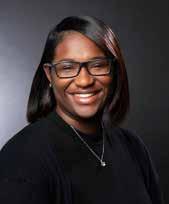
Rodshea Jordan is a Personal Banker in our Retail Floater Pool. Because she is a floater, she has had an immense impact on every

Columbia has 176 nonprofit organizations, and the annual CoMo Gives fundraising campaign is just around the corner. (Yay! End-of-the-year charitable contributions.) Some of the awesome feedback we got is included below but make no mistake: The No. 1 need is cash.
Really cash is the most valuable to a NP. Nothing compares to the bene t of unrestricted cash. Nonpro ts still have to pay for utilities, rent, payroll, etc., but a lot of donations are restricted and can’t be used for basic operating costs.
– ANGELA HUNTINGTON
Second Chance is in desperate need of a new washer/dryer. Cleaning supplies are always nice, too.
– NATALIE HEATH
Freeair Books is a nonpro t online bookstore that also accepts donated books. It is a minority/women owned business in Columbia dedicated to promoting inclusivity and elevating literacy rates.
— GW NORMAN III
Central Missouri Community Action maintains a Women and Infant Relief Fund and could use any and all baby supplies, furniture, and clothing. We are also selling a ordable homes and could use gift baskets for rst time homeowners
with things like cleaning supplies, re extinguishers, and basic decorations.
— DARIN PREIS
At First Chance for Children we are the primary diaper bank for central Missouri. We partner with over 30 agencies in central Missouri to distribute diapers and wipes to families in need. Obviously, there is a greater need than can be met. As it stands, nearly 1 in 2 families in the U.S. struggle to a ord diapers for their children. Diaper need is a widespread issue, and it underscores how the cost of such basic necessities puts many families in similar situations. Diaper costs are a challenge for families across the income spectrum.
— GAY LITTEKEN
Central Missouri Humane Society runs a food bank for pet food.
— BROOKE DICKERSON
Show-Me Central Habitat for Humanity could use all of your lawn equipment, tools that you cleaned out of your dad’s garage (there are
six of everything and you KNOW IT!), remodel/building materials that are used or unused, furniture, dishes, knick-knacks, holiday items. Your excess that is donated the Habitat ReStore becomes funds to build Habitat for Humanity homes. We also love to give our homeowners “Welcome Home” baskets when they move in. It has basic needs like toilet paper/paper towels, cleaning supplies, broom/mop/dustpan, etc. to get them started in their new home.
— ASHLEY BURK SWITZER
Excess craft supplies or art-making tools for our classes at Access Arts are appreciated, and what we can’t use we share with the CoMo Como Craftcycle Collective or other nonpro t friends. Please call or email rst before you donate to make sure we can handle whatever it is you are looking to rehome!
— SARAH CATLIN
True North Columbia has need for cleaning product, hygiene products, and similar items.

Nov 2 - Jan 4
There’s no time like Christmastime at Silver Dollar City, with over 6.5 million twinkling lights and holiday shows that sparkle on every stage. The magic of the season shines from the top of the 8-story tree to the jingle of jolly that parades through the streets. Plus, hearty homestyle feasts to share and handcrafted gifts made right before your very eyes. It’s America’s Best Holiday Event and it promises to be your family’s newest Christmas tradition! Make plans today at silverdollarcity.com
